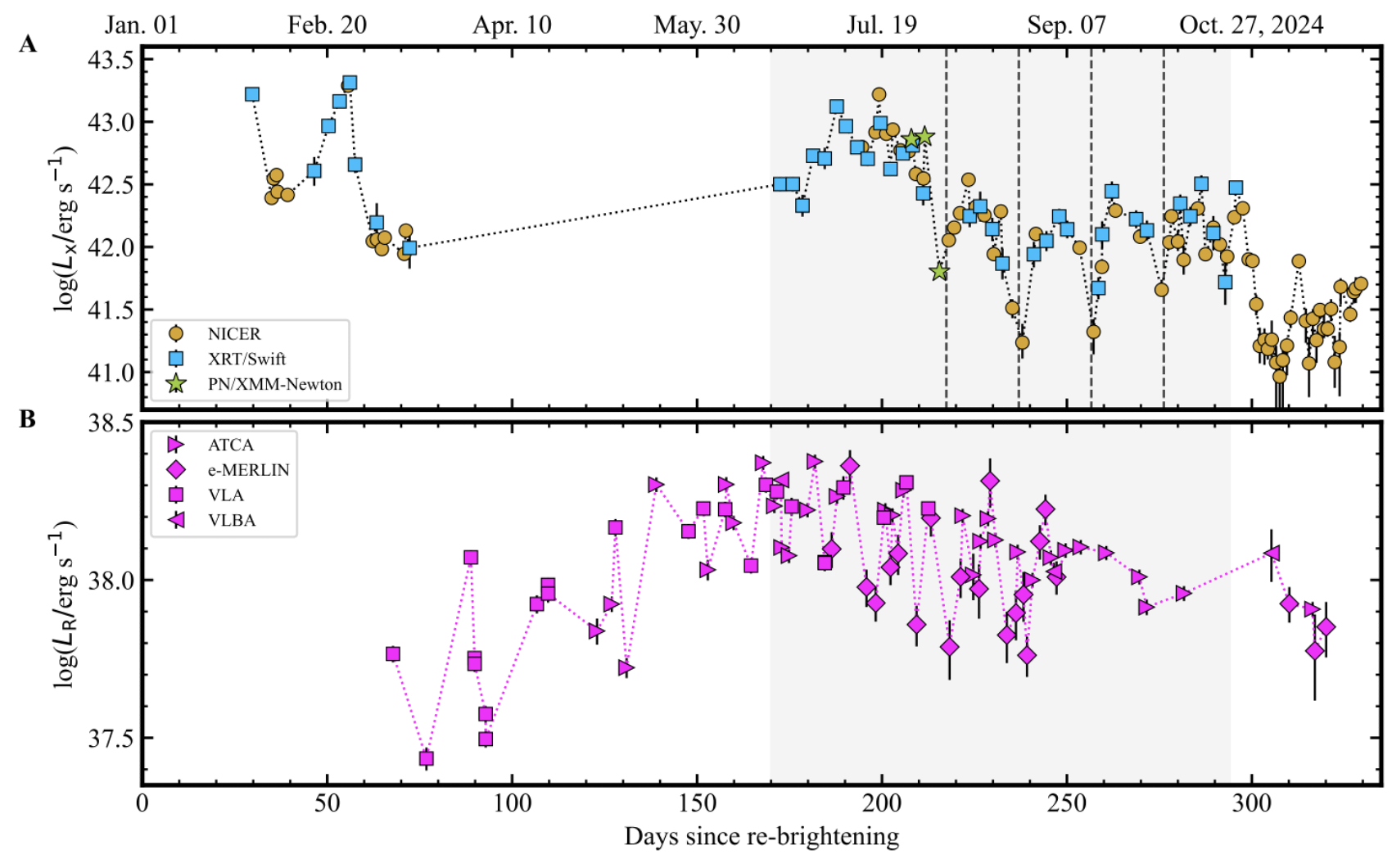
Astronomers Reveal a Co-Precessing Black Hole Disk-Jet System
December 2025
The first evidence of co-precession of a black hole accretion disk and jet for TDE has been discovered.

December 2025
The first evidence of co-precession of a black hole accretion disk and jet for TDE has been discovered.
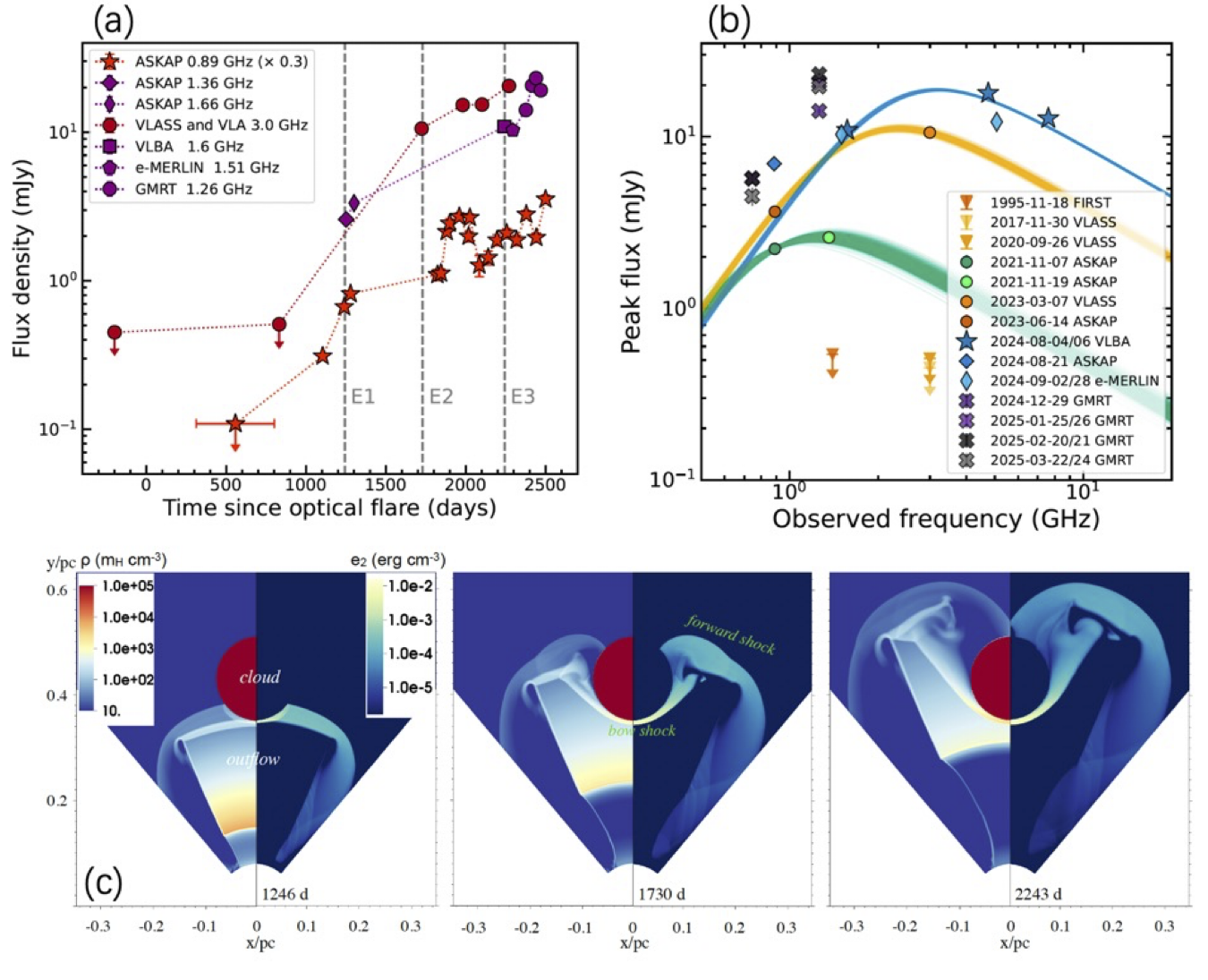
November 2025
A suite of international arrays including e-MERLIN have found a second radio bump more than 6 years after the initial source detection.

November 2025
A thermal electron population has been identified in a jetted transient for the first time using radio and sub-mm observations of the tidal disruption event (TDE).
October 2025
The new Opticon RadioNet Pilot proposal tool developed at Jodrell Bank is now ready for use for the Cycle 21 e-MERLIN Call for proposals!

October 2025
e-MERLIN observations of the outburst of MAXI J1820+070 have informed relativistic hydrodynamic simulations of X-ray binary jets and their evolution

October 2025
Using an international array of radio telescopes including Jodrell Bank, a low mass dark object in the distant Universe has been detected from the tiny gravitational distortion of its light from another distant galaxy
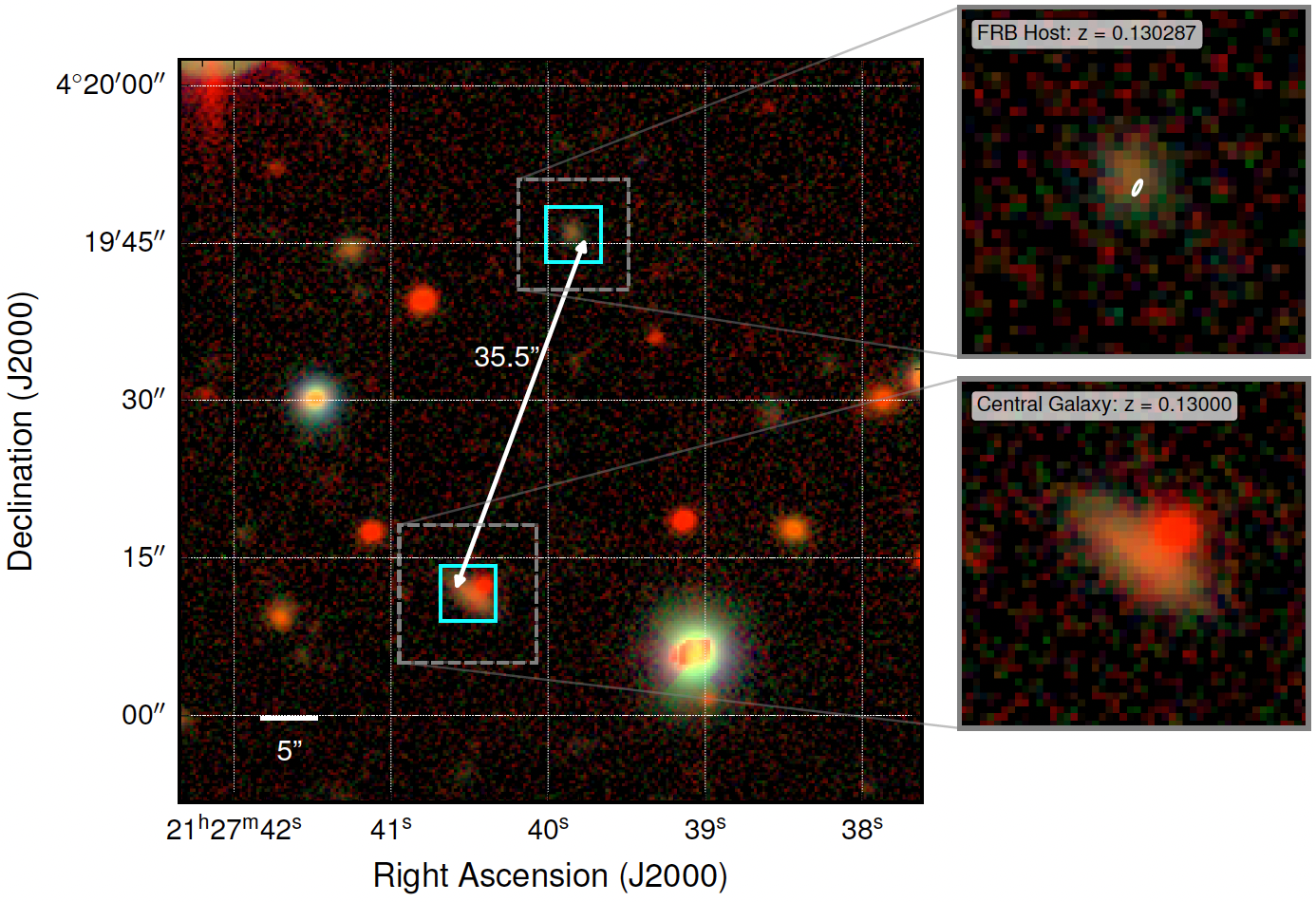
September 2025
e-MERLIN has joined the PRECISE project once again to locate a FRB to milliarsecond precision.
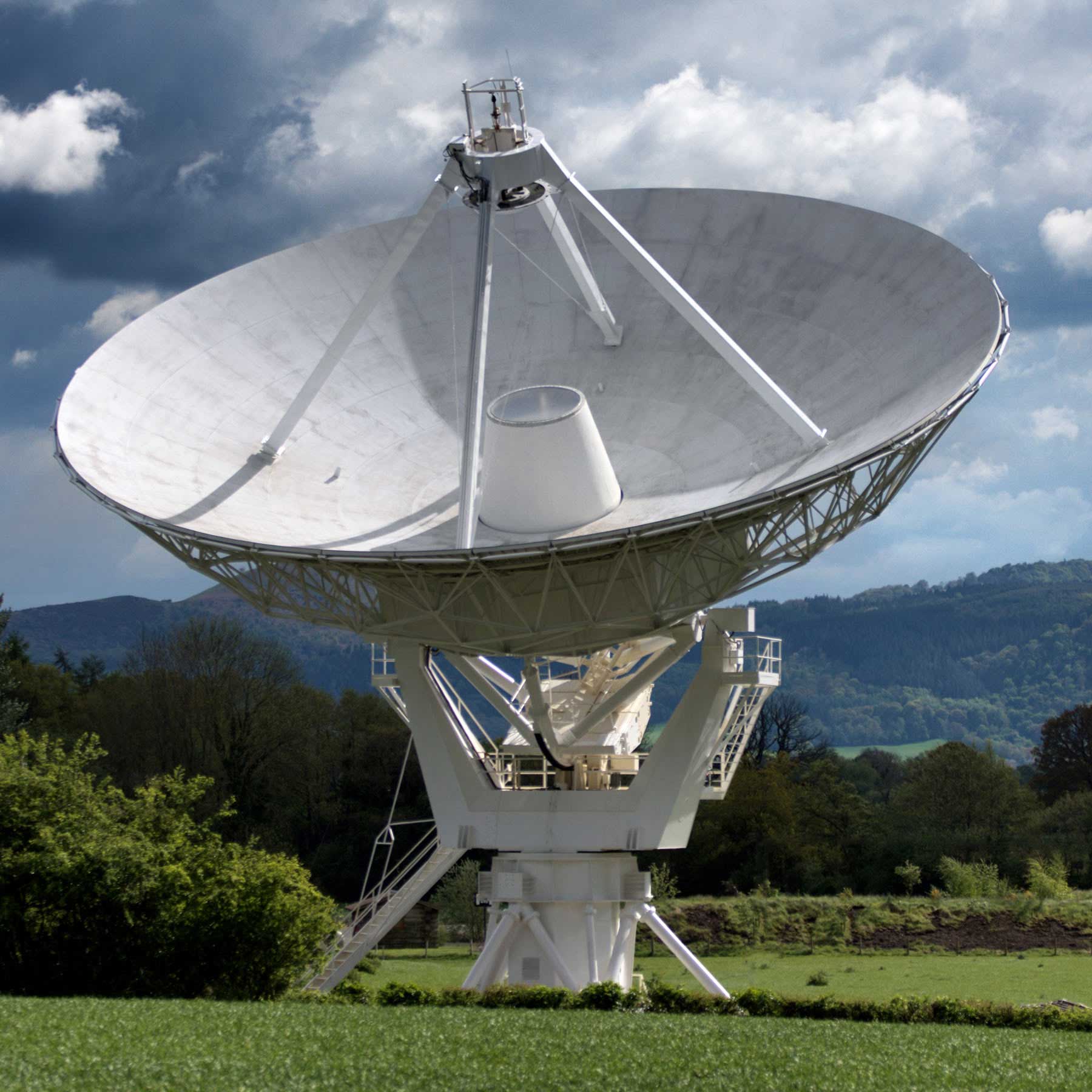
July 2025
The e-MERLIN Cycle 25 call for proposals list of accepted proposals have been announced

June 2025
South Africa’s MeerKAT radio telescope has successfully conducted very long baseline interferometry (VLBI) observations with telescopes of the European VLBI Network (EVN) — currently the world’s most sensitive VLBI network—which includes the UK’s national VLBI facility, e-MERLIN.

June 2025
Excited OH and methanol masers have been found to co-exist in 6/10 high mass star forming objects (HMYSOs) using e-MERLIN observations, probing magnetic fields and physical conditions of the nearby environment.
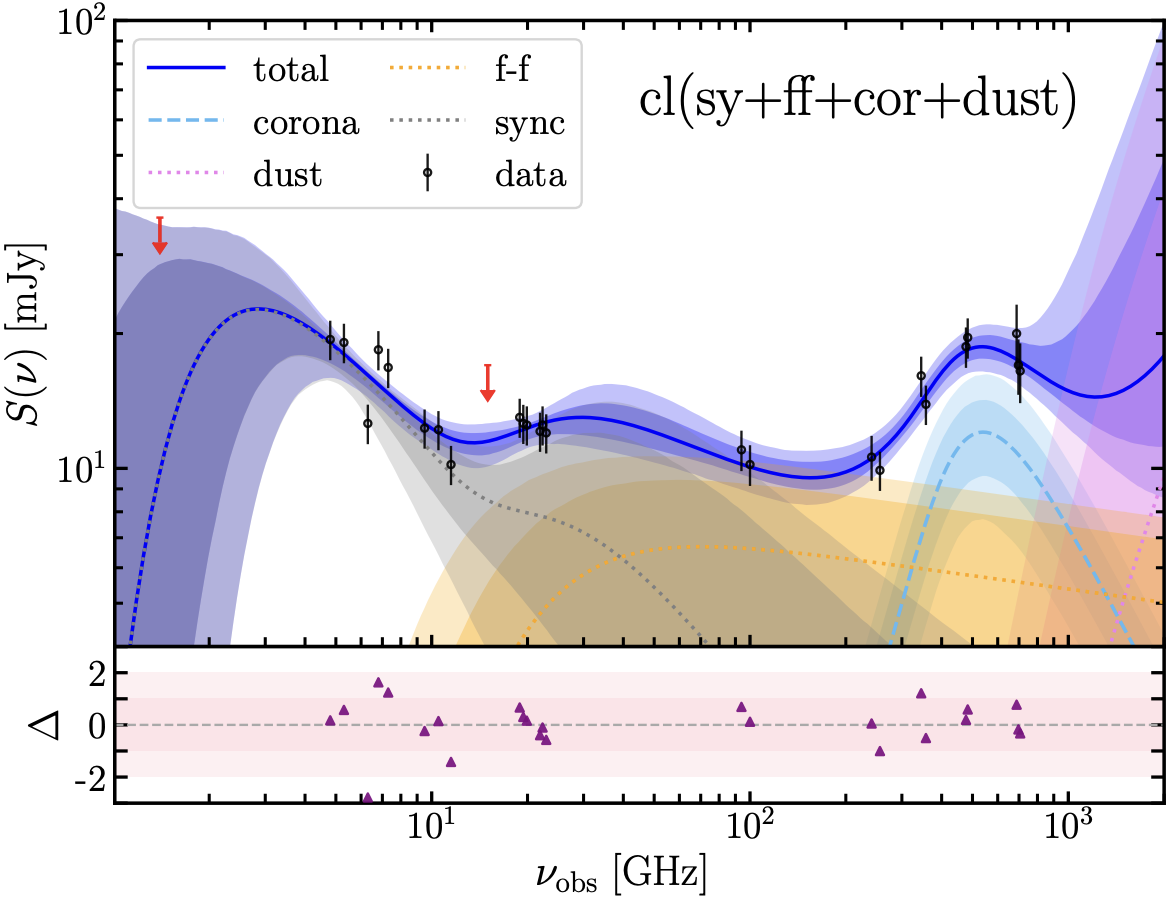
May 2025
A consistent parsec scale analysis of the nuclear region shows evidence for a corona: a previously unexplained sub-mm excess emission between ~200-700 GHz
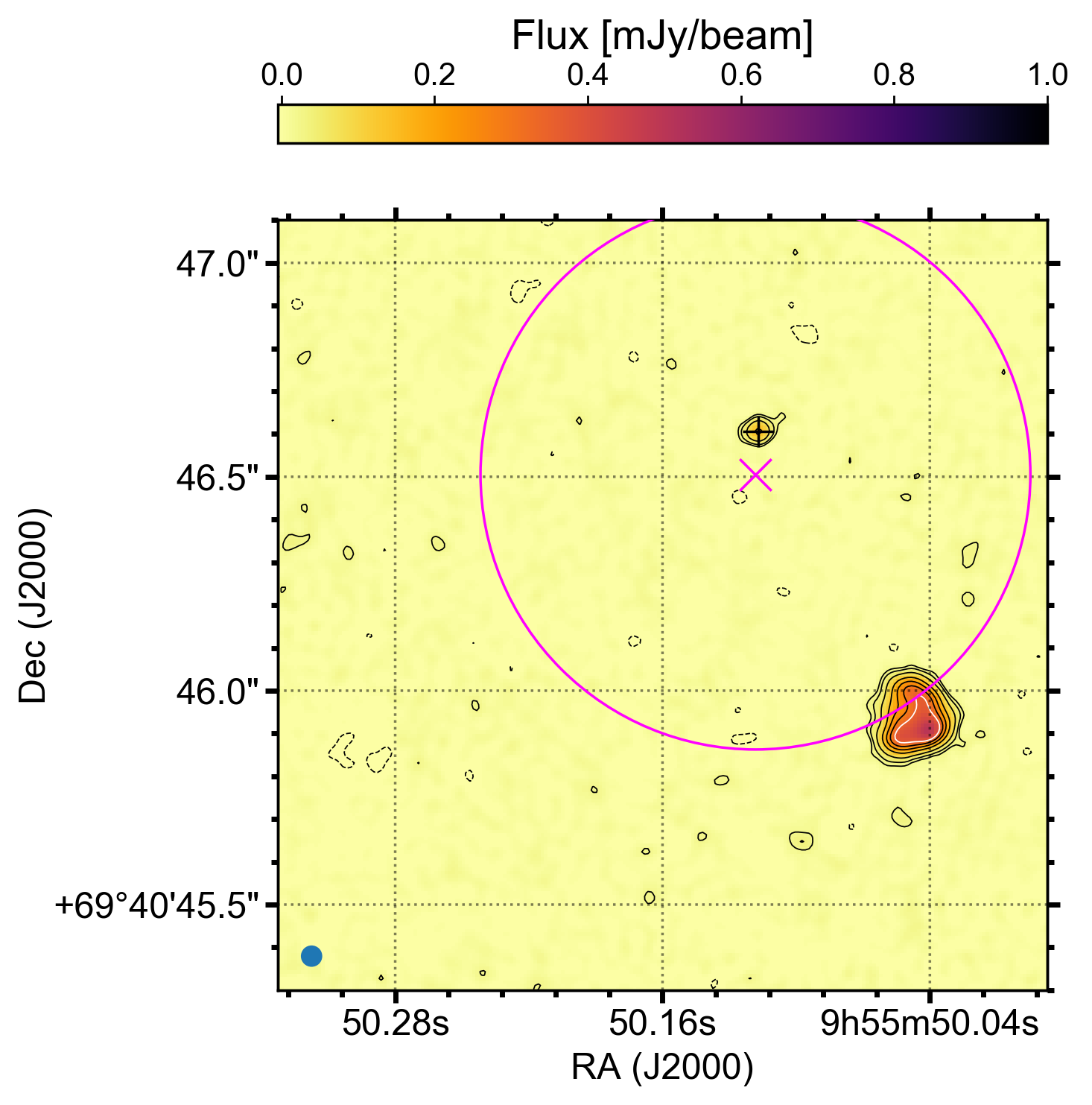
May 2025
The elusive intermediate-mass black hole candidate has been detected for the first time in the radio with archival e-MERLIN and EVN data
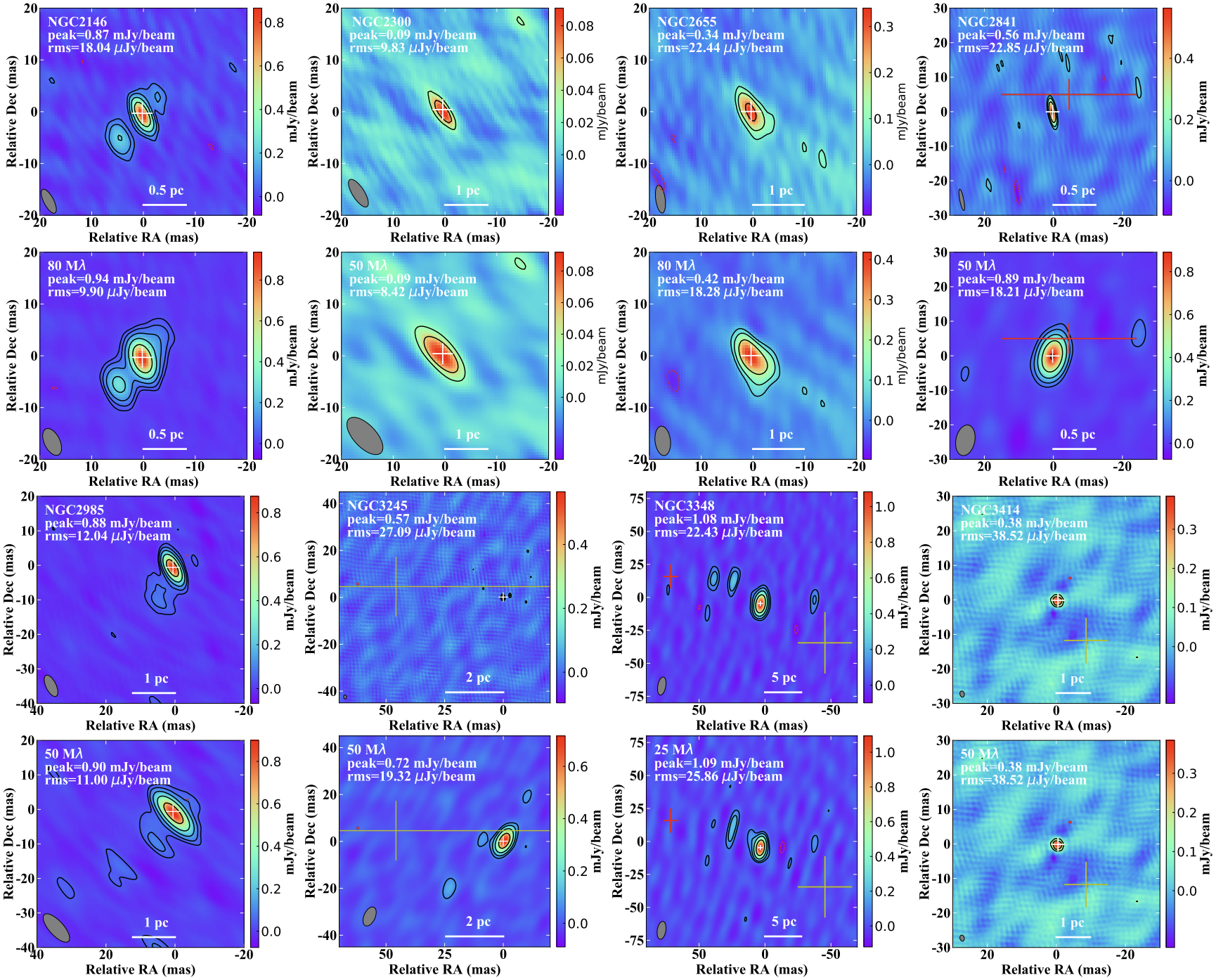
April 2025
Using the EVN the parsec-scale cores of some nearby galaxies have been revealed for the first time
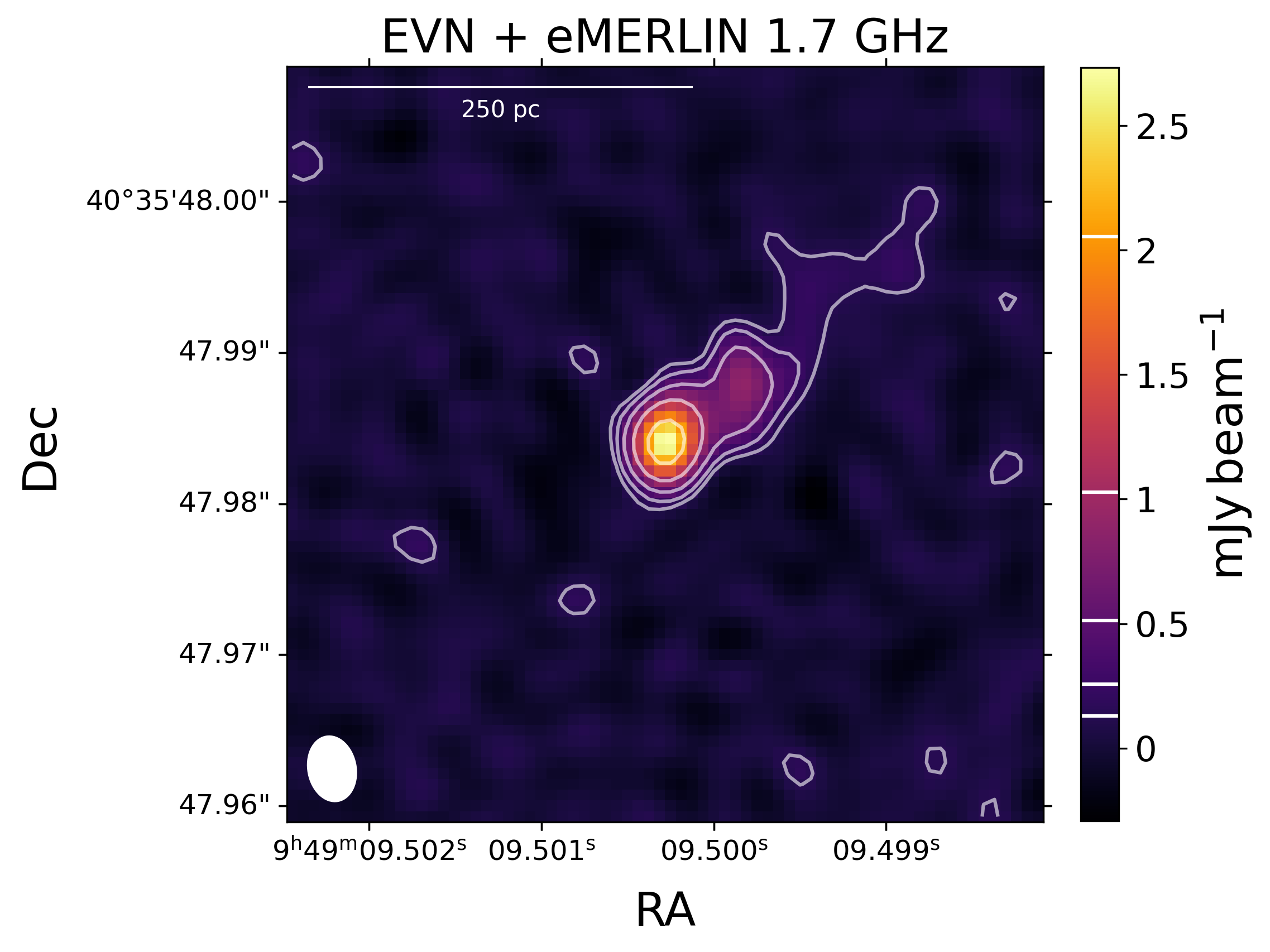
April 2025
A new synoptic survey mode for EVN+e-MERLIN observations will revolutionise statistical studies of the VLBI sky
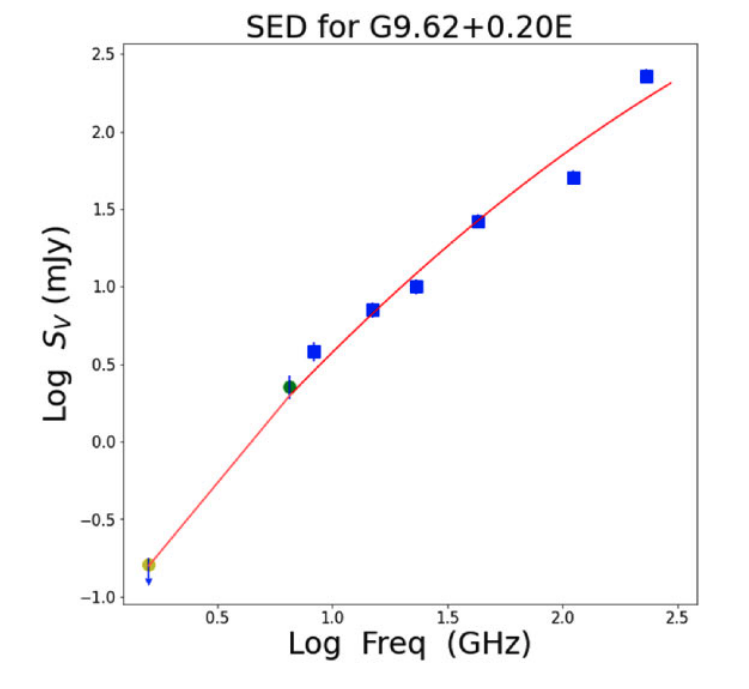
March 2025
High-resolution e-MERLIN observations of the continuum emission in G9.62+0.20E suggest optically-thick emission at lower frequencies
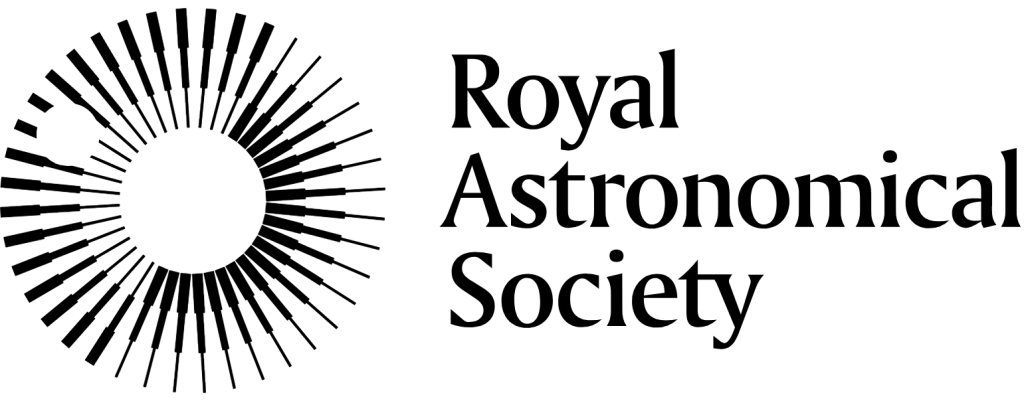
March 2025
Join a plethora of other SKA Pathfinder scientists including e-MERLIN at NAM 2025 in Durham.
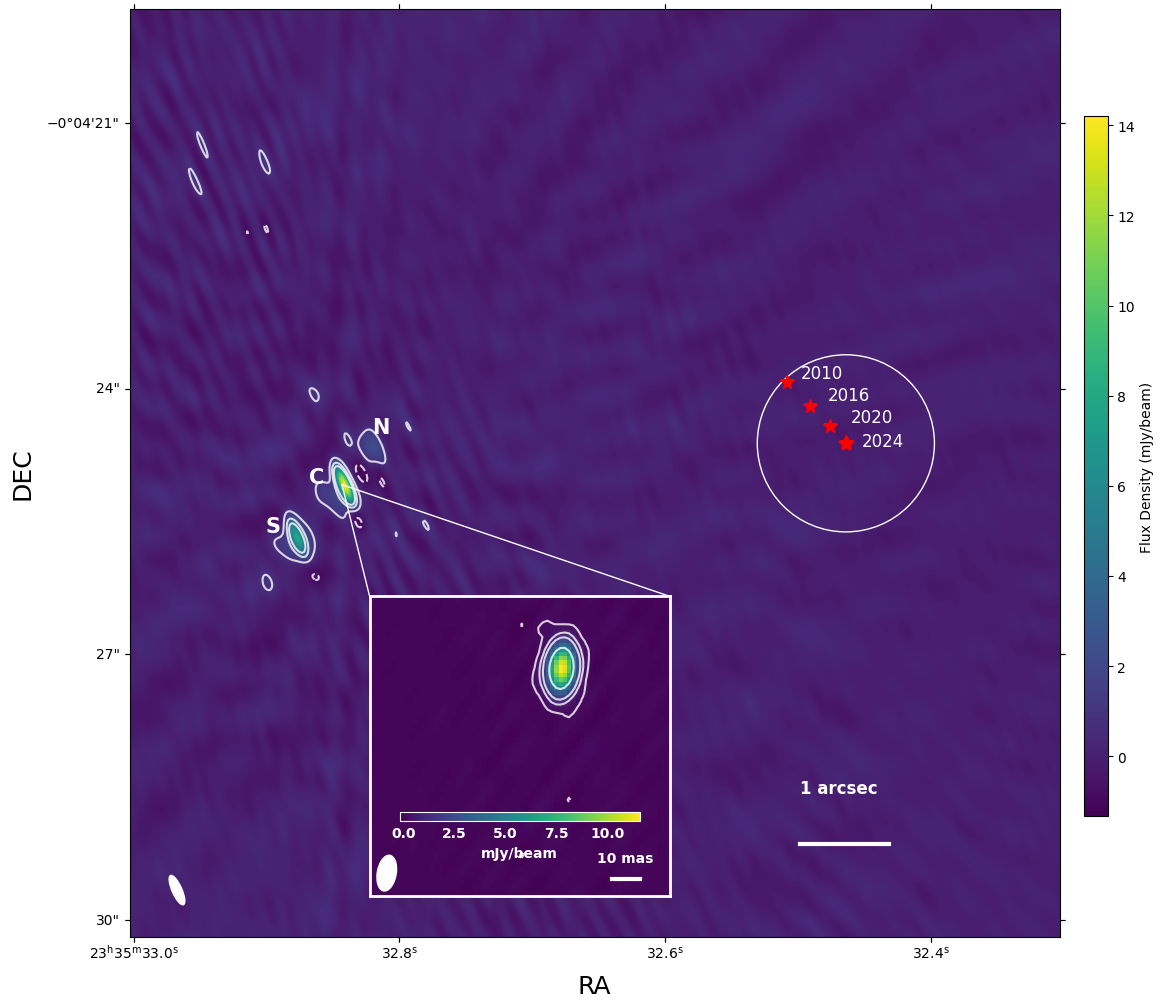
February 2025
High-resolution e-MERLIN observations revealed three compact AGN components contaminating the candidate star’s mid-infrared light.
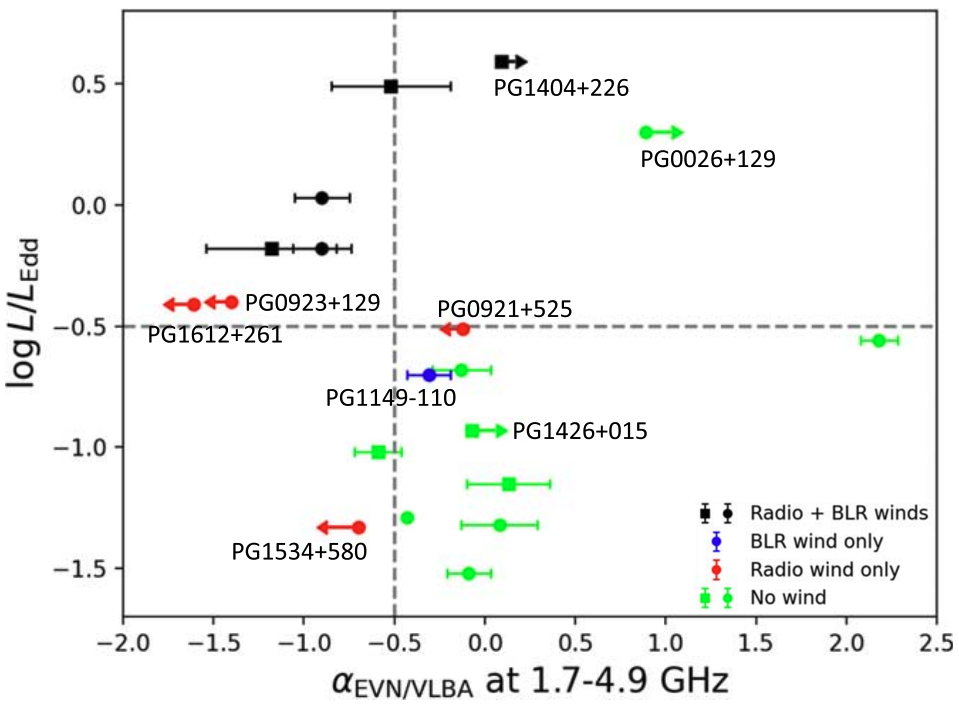
February 2025
Radio-quiet Quasars show evidence for winds at high Eddington ratios.
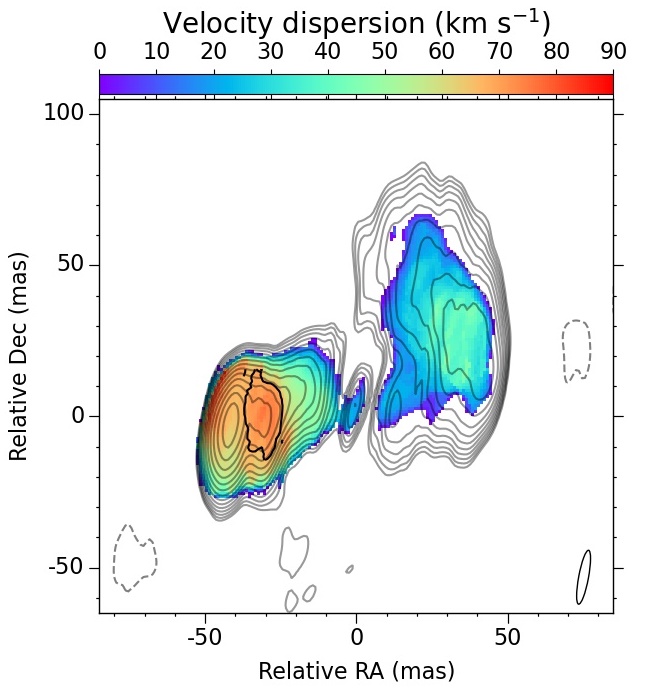
January 2025
EVN+e-MERLIN observations investigate the cold gas outflows in the very young radio source, 4C 31.04
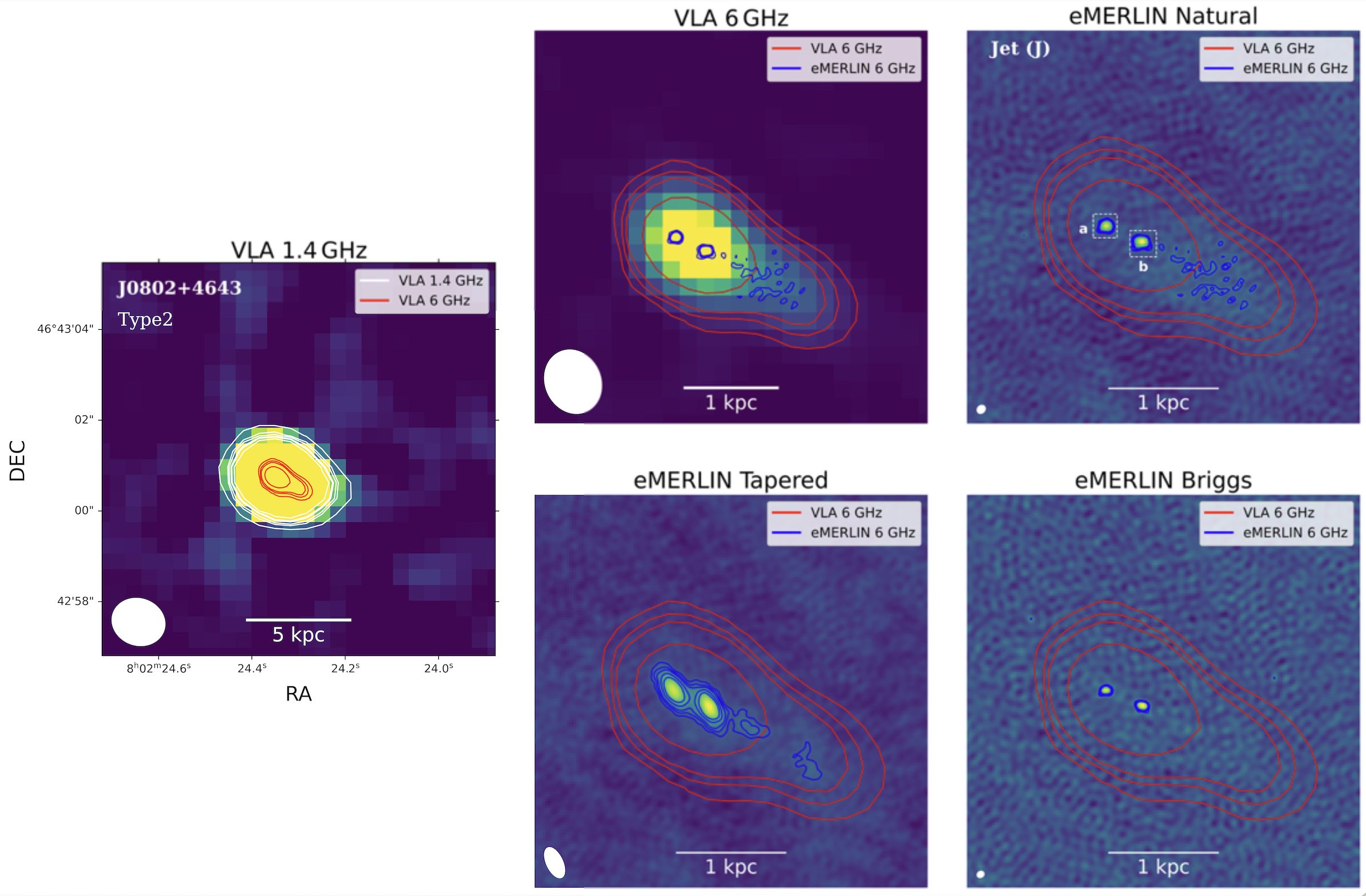
January 2025
The nature and origin of radio emission in most radio-quiet quasars remain ambiguous based on all-sky, low-resolution surveys.

December 2024
The e-MERLIN Cycle 19 call for proposals list of accepted proposals have been announced

October 2024
e-MERLIN observations of OH masers confirm outflowing gas in Zw049.057
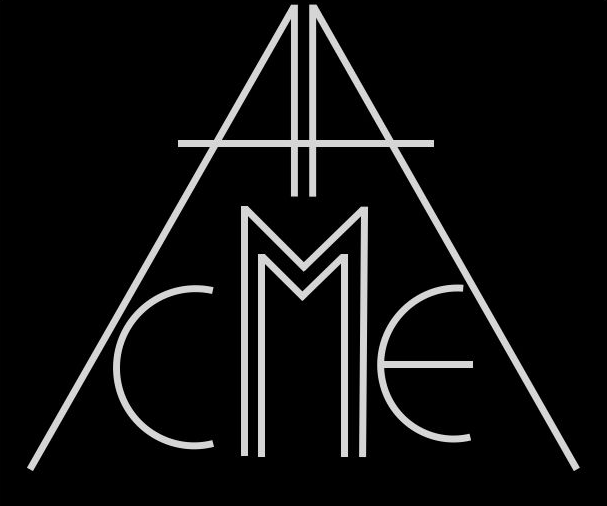
September 2024
e-MERLIN joins a new EU-funded project dedicated to multi-messenger astronomy

July 2024
The e-MERLIN Cycle 18 call for proposals list of accepted proposals have been announced
The first evidence of co-precession of a black hole accretion disk and jet for TDE has been discovered.
A tidal disruption event (TDE) occurs when a star approaches a supermassive black hole at the center of a galaxy and is torn apart by tidal forces. Some of the stellar material falls back to form a hot accretion disk, releasing intense radiation. TDEs are important windows for studying the activation of quiescent black holes and the formation of relativistic jets. An international research team, studying a TDE named AT2020afhd led by Yanan Wang, has found the most compelling evidence of co-precession between a black hole’s accretion disk and its jet over time.
At approximately 120 million light-years from Earth, AT2020afhd was discovered in January 2024 by an optical survey due to a significant re-brightening and was later confirmed as a TDE. The research team quickly organized an international coordinated observation campaign, including e-MERLIN, mobilizing multiple space- and ground-based telescopes for over a year of high-cadence, multi-wavelength monitoring. X-ray, radio and optical telescopes all participated, achieving full-wavelength coverage of the event.

After analyzing the extensive observational data, the team made a key breakthrough: approximately 215 days after the event, the X-ray light curve exhibited a pronounced quasi-periodic oscillation with a period of about 19.6 days and an amplitude more than 10-fold increase in flux. The radio band also showed strong short-term variability exceeding a 4-fold amplitude, highly synchronized with the X-ray variations. All of this is indicative of a precessing jet and accretion disk.

The disk-jet co-precession observed in certain black hole systems is likely driven by the Lense-Thirring effect, a frame-dragging phenomenon predicted by Einstein’s general relativity. In this effect, a spinning black hole drags the surrounding spacetime, causing an inclined accretion disk and its perpendicular jet to undergo precession. While this phenomenon has been long predicted by theoretical studies and simulations, obtaining direct observational evidence has proven extremely challenging. To address this, the team conducted continuous monitoring over the course of more than a year. Building on these observations, they developed a model of disk-jet coordinated precession that successfully reproduces the observed X-ray and radio variability, providing stringent constraints on the system’s geometric configuration, black hole spin, and jet velocity.
Read the full article here (Wang et al. 2025).
A suite of international arrays including e-MERLIN have found a second radio bump more than 6 years after the initial source detection.
While dozens of tidal disruption events (TDEs) have been identified, that occur when a strayed star approaches too close to a massive black hole and is torn apart by black hole’s gravitational force, only a few are known to produce relativistic jets. Recent observations have suggested that delayed brightening of radio emission appears ubiquitous among TDEs, whose physical origins are still in dispute.
In a recent work by Yang et al. (2025), a team of astronomers has discovered the long-sustained rising radio emission from a TDE occurring in a dwarf galaxy, using a suite of radio telescopes including e-MERLIN. The TDE, designated AT2018cqh, was initially detected by the Zwicky Transient Facility at optical in June 2018 and the eROSITA at X-ray wavelengths in November 2019. In addition to the continuous rise in the radio emission up to ~2510 days since its discovery, the observations found repeating bump features in the light curve, which is unprecedented among known TDEs. The radio spectral evolution is also peculiar, characterized by a shift toward higher peak frequency and peak flux density with time, as evidenced by the quasi-simultaneous e-MERLIN and VLBA observations. This is in contrast to the radio evolution behaviours observed in any other TDEs. The joint observations revealed extreme compactness of the radio emission, unresolved at a scale of <0.2 pc. The team’s analysis, combined with the hydrodynamic simulations, suggests that the extraordinary radio evolution could result from the interaction of outflows launched by TDE with the sub-pc dense clouds surrounding black hole, offering new insights into the origins of delayed fast-rising radio emission observed in some TDEs.
A thermal electron population has been identified in a jetted transient for the first time using radio and sub-mm observations of the tidal disruption event.
Relativistic tidal disruption events (TDEs) are rare, luminous, multi-wavelength transients that occur when a relativistic outflow is launched from a supermassive black hole during the disruption of a star. To date there are only handful of confirmed relativistic TDEs and only two that have been studied in detail. As a result, there are many unanswered questions ranging from focusing on the events themselves: ‘why do only some TDEs launch jets?’ or ‘what are the properties of the TDE jets?’, to much larger scale questions like ‘what is the connection between TDEs and AGN?’.
In a recent work by Rhodes et al (2025), radio and sub-mm observations from a suite of facilities, including e-MERLIN were combined to study the newest relativistic TDE AT2022cmc. Comparisons to the best-studied relativistic TDE, Swift J1644, showed that the light curve evolution was similar in both cases, but AT2022cmc was twice as energetic despite Swift J1644 being systematically more luminous (see Figure 1).
The observations found that the broadband emission is not consistent with only non-thermal synchrotron radiation as is expected from relativistic jets like those associated with gamma-ray bursts. Instead, there is evidence for both thermal and non-thermal electron populations, providing a new insight into the particle acceleration process in jets. The authors find that the Lorentz factor of the jet sits in a region of parameter space higher than those from X-ray binaries and lower than those from gamma-ray bursts, neither of which show evidence of thermal electrons, potentially providing a new avenue for understanding how the radio emission from jets varies as a function of outflow velocity (see Figure 2).
The new Opticon RadioNet Pilot proposal tool developed at Jodrell Bank is now ready for use for the Cycle 21 e-MERLIN Call for proposals!
As part of Cycle 21 of the e-MERLIN call for proposals, software developers at Jodrell Bank have created a new proposal software tool designed to replace the current NorthStar proposal tool. The new tool, named Polaris, was developed as part of the Opticon RadioNET Pilot (ORP), an EU Horizon 2020 project to facilitate collaboration between existing optical and radio astronomy groups across Europe.
To help support users transition to using the new tool, we will be running a Polaris online webinar on Wednesday 12th November 2025 at 1300 GMT. Please get in contact with the e-MERLIN support team for details on how to join this webinar. This project has received funding from the European Union’s Horizon 2020 research and innovation programme under grant agreement No 101004719.
e-MERLIN observations of the outburst of MAXI J1820+070 have informed relativistic hydrodynamic simulations of X-ray binary jets and their evolution
X-ray binaries (XRBs) are one of the best laboratories for studying a wide-range of astrophysical phenomena: from the connection between accretion and the ejection of jets, to the resulting shock physics as these jets interact with the interstellar medium (ISM). Importantly, they evolve on humanly-accessible timescales and are found at distances that can resolve these discrete components with VLBI arrays like e-MERLIN. By studying such ejecta, important discoveries can be made that can inform our understanding of the launching of radio jets from active galactic nuclei and gamma ray bursts, as well as how the jets shape their own galaxies or immediate environment. Whilst simulations of XRB jets have already helped to provide information on the steady jets, further study of the discrete ejecta is needed to understand the energy transferred into the ISM and constrain the environments that lead to bright and/or relativistic jets.
In this work by Katie Savard and collaborators, they use e-MERLIN and MeerKAT data of the X-ray binary MAXI J1820+070 during its 2018 outburst (Bright et al. 2020) to inform the initial conditions of the relativistic ejecta (Figure 1). Subsequently, this information is used as priors for a hydrodynamic simulation to obtain physical parameters about the ISM and the ejecta, such as the density and particle acceleration efficiencies, which would otherwise remain unconstrained by the data alone. The Pluto code (Mignone et al 2007b) was used to perform relativistic magnetohydrodynamic simulations of the jets as they evolve and interact with the environment.
The simulations showed that the radio blobs ejected by MAXI J1820+070 must be significantly denser than the surrounding ISM in order to propagate to large distances away from the black hole (Figure 2). The low-density environment is explained by ejecta from previous outburst propagating into the ISM causing a high-pressure low-density cavity. This also naturally provides an explanation for the `bubble-like' cavities seen in other sources. The simulations also reveal the presence of a long-lived reverse shock which causes in-situ particle acceleration.
The output of the simulations was then fed into BLOB-RENDER, a tool created to generate pseudo-radio images which can then be used to model the expected sizes, shapes and fluxes of the ejecta (see Fig 3). By incorporating the uv coverage of the MeerKAT and e-MERLIN arrays, it was possible to simulate the original observations together with a real-sky background. The use of this tool enables more direct understanding and interpretation of the simulations, whilst also providing potential uses for predicting future array capabilities of e-MERLIN and other telescopes.
An international team of astronomers has found a low mass dark object in the distant Universe, not by directly observing any emitted light, but by detecting its tiny gravitational distortion of the light from another distant galaxy. Using a special technique called gravitational imaging, it was possible to 'observe' the invisible dark matter clump by mapping its gravitational lensing effect against the radio-luminous arc.
Gravitational lensing is caused by light from a distant object bending around a massive foreground object like a galaxy, causing the background object to be magnified/distorted in large arcs (Figure 1). The gravitational lens source JVAS B1938+666 is caused by a foreground luminous infrared galaxy at the centre of the ring, resulting in stunning arcs known as an "Einstein ring". By studying and measuring the size and shape of the arcs, it is possible to gain information on both the matter content of the lens, in this case the foreground galaxy, but also the distant background object too. Without the lens, the background object would be too faint to study, which makes gravitational lenses excellent laboratories for understanding the expansion of the Universe and dark matter.
Using an international array including the e-MERLIN telescopes, the team led by Devon Powell and John McKean discovered a low mass dark object in the gravitational lensing system B1938+666 (Figure 1 and 2). By using sophisticated modelling algorithms, the team managed to gravitationally 'image' the object, despite it not being detected at optical, infrared or radio wavelengths. This mysterious object has a mass of about one million times that of our Sun. It is located in a distant region of space, approximately 10 billion light years from Earth, when the Universe was only 6.5 billion years old. It's discovery seems consistent with the current best theory about how galaxies like our own Milky Way formed. This is the lowest mass object to be found using this technique, by a factor of about 100.
The team are now analysing the data further to better understand what the mysterious dark object could be. Further work to look at other parts of the sky to find more examples of such low-mass dark objects using the same technique are also underway. If more of these mysterious objects are found in other parts of the Universe, and if they turn out to be completely devoid of stars, then some theories of dark matter may be ruled out.
e-MERLIN has joined the PRECISE project once again to locate a FRB to milliarsecond precision.
An important way to study fast radio bursts (FRBs) is to determine from what type of galaxies they originate and what their local properties are. Fast radio bursts (FRBs) are extragalactic radio flashes of unknown origin(s). They typically last on the order of a millisecond. A small fraction (~3%) of all FRBs have been observed to repeat. The most precise localizations of (repeating) FRBs are achieved with the EVN.
In this work by Mohit Bhardwaj, Mark Snelders and collaborators, the recently detected hyperactive repeating FRB 20240114A (thus detected on 2024 January 14), was localised using the EVN in EVN-Lite mode (PRECISE; Pinpointing REpeating ChIme/FRB Sources with EVN dishes; PI: Franz Kirsten). It is called a hyperactive repeater because thousands of bursts from this source have been found since its discovery using multiple radio telescopes over the world. The observations are done at 1.4 GHz with an ad-hoc sub-array of EVN dishes. For these observations we made use of Effelsberg (Germany), Toruń (Poland), Onsala O8 (Sweden), Westerbork RT-1 (The Netherlands), Noto (Italy), Irbene (Latvia) and six e-MERLIN stations (Cambridge, Darnhall, Defford, Knockin, Pickmere, and Jodrell Bank Mark II; United Kingdom).
The FRB was localised to low-metallicity star-forming dwarf galaxy at a redshift of z = 0.130287. The host was found to be gravitationally bound to a more massive nearby (85 kpc) galaxy at the same redshift. These results expand the known diversity of FRB host environments and offers important insights for interpreting seemingly 'hostless' or highly offset FRBs. Hopefully, future space-based optical/infrared observations (e.g., with Hubble or James Webb Space Telescopes) will reveal the local environment of this FRB source and will fully leverage our precise radio localization.
The e-MERLIN Time Allocation Group met on 3rd July 2025 to consider proposals for Cycle-20. Proposals were received for L-Band (1.3-1.7 GHz) and C-Band (4.5-7.5GHz). The amount of time approved is set by existing programme observation requirements, scheduling and engineering constraints, and by EVN commitments within the Cycle-20 period. However the amount of available observing time in Cycle 20 has been reduced due to test requirements associated with planned e-MERLIN technical developments.
The e-MERLIN Cycle 20 call for proposals list of accepted proposals is below (in no particular order). The next call for proposals is anticipated in Autumn 2025.
South Africa’s MeerKAT radio telescope has successfully conducted very long baseline interferometry (VLBI) observations with telescopes of the European VLBI Network (EVN) — currently the world’s most sensitive VLBI network—which includes the UK’s national VLBI facility, e-MERLIN. Their synergy sets a new standard for global collaboration and significantly enhances both resolution and sensitivity, opening new avenues for scientific exploration.
The collaboration between MeerKAT and the EVN demonstrated, for the first time, how a highly sensitive, modern radio interferometer telescope in the southern hemisphere can significantly enhance the capabilities of existing VLBI networks at centimetre wavelengths. With MeerKAT contributing to the EVN observations, both sensitivity and resolution were considerably improved, as clearly shown in the images below. This is a mutually beneficial partnership with enormous potential for science.
The significance of this collaboration is far-reaching. It paves the way for future international partnerships that could lead to unique scientific discoveries. MeerKAT is the precursor to the mid-frequency array of the Square Kilometre Array Observatory (SKAO) in South Africa, now under construction, which is designed to deliver high-quality data products with exceptional efficiency. This role makes it a crucial pathfinder for future projects and collaborations. MeerKAT’s partnership with the EVN showcases innovative methods for scientific research with this cutting-edge instrument and lays the groundwork for realising SKA-VLBI in the future.
The integration of MeerKAT into the EVN has been prepared through various dedicated tests since 2022-2023. This observation, however, marks the first time MeerKAT has participated in a full, regular EVN observation, in the same way as the other EVN telescopes, including those of the e-MERLIN array. The initial results of this observation, shown in the accompanying images, confirm MeerKAT’s potential as a powerful VLBI station. This represents a significant milestone for science, given the prominent roles of both MeerKAT and the EVN in global astronomical research.
Excited OH and methanol masers have been found to co-exist in 6/10 high mass young stellar objects (HMYSOs) using e-MERLIN observations, probing magnetic fields and physical conditions of the nearby environment.
High-mass young stellar objects (HMYSOs) arise in giant molecular clouds, consisting of a huge amount of gas and dust, which prevents direct observation of the close ambient environment of the forming star at optical frequencies. To track these inner regions, maser emissions in the radio band can be used. The most popular species is the 6.7 GHz methanol maser, which is excited via thermal, infrared dust radiation. The other, less common, 6.035 GHz ex-OH maser is pumped in the same way. But, as current theoretical models show, this maser may arise in the same warm region as the 6.7 GHz transition or may occur in the denser and cooler regions, where the 6.7 GHz transition cannot exist.
The 6.7 GHz methanol and 6.035 GHz ex-OH masers were observed in ten high-mass young stellar objects (HMYSOs) with e-MERLIN by Agnieszka Kobak and collaborators. Among them, eight ex-OH sources were imaged for the first time. Simultaneous observations located the regions of coincidence (or avoidance) of both transitions and showed they are related to local changes in temperatures and/or densities, for scales of a few hundred astronomical units, which are directly associated with the brightness and the distance from HMYSO. The comparison with archival ALMA data shows that coincidence did not relate to kinematic features like discs or outflows. Also, the analysis of evolutionary stage, based on ultra-compact HII counterparts, ratio of 70 micron to 24 micron flux, and ratio of bolometric luminosity to mass, shows that the age of HMYSO did not correlate with coincidence.
The observations were also conducted in full polarization mode to measure the magnetic field for ex-OH masers. The estimation of magnetic field strength gave the typical values from 0.2 to 10.6 mG; for two sources, the reversal of magnetic field direction was observed. The orientations of the magnetic field on the sky-plane seem not to be related to the directions of outflow.
A consistent parsec scale analysis of the nuclear region shows evidence for a corona: a previously unexplained sub-mm excess emission between 200-700 GHz
Previous observations of the nearby radio-quiet Seyfert 2 galaxy showed an unexplained sub-mm excess emission between 200-700 GHz, which was consistent with synchrotron emission from a compact, optically thick corona with approximately 70±5 gravitational radii. This corona contained about 10±2% of its energy density in non-thermal electrons and possessed a magnetic field strength of roughly 148 Gauss, with its spectral energy distribution peaking at approximately 550 GHz. While the corona's luminosity aligned with expectations from mm-X-ray correlations in radio-quiet AGN (though slightly higher), the emission between 10-200 GHz appeared to be dominated by free-free emission rather than coronal processes.
By combining radio to sub-millimetre observations from e-MERLIN, the VLA, and ALMA to study the nucleus of NGC 1068, Isaac Mutie and collaborators have constructed a detailed spectral energy distribution (SED) of the bright, compact region near the galaxy’s central black hole. To perform this work, they matched the data in angular resolution and spatial frequency coverage between 4.5 and 706 GHz, providing a ~100 mas resolution image in each dataset to provide a consistent parsec scale analysis, removing uncertainty on the SED measurements from previous studies. Their findings reveal that the nuclear region is complex, with part of the emission arising from hot, ionised gas via thermal free-free processes, and additional signals originating from a compact corona of high-energy particles, possibly accompanied by synchrotron radiation below 5 GHz. Through careful SED modelling, these combined emission processes successfully reproduce the observed data, including the coronal bump in the 200-700 GHz range, thereby refining our understanding of the interactions between energetic particles in the vicinity of the supermassive black hole and the origin of radio emission in the radio quiet AGN of NGC 1068.
Future observations with e-MERLIN, the VLA, and ALMA, extending this sample to include more nearby radio-quiet galaxies, will be important in understanding the origin of radio emission in such systems by disentangling the contributing mechanisms. Additional high-resolution, low-frequency observations with instruments such as LOFAR and SKA-LOW will also be crucial to constraining the SED at megahertz frequencies.
The elusive intermediate-mass black hole candidate has been detected for the first time in the radio with archival e-MERLIN and EVN data
The nearby starburst galaxy is full of supernova remnants and ultra compact HII regions, which can only be observed in the radio band due to the high optical extinction from the gas and dust in the galaxy. In addition to this population of sources, several exotic radio transients have been discovered in the past, such as SN2008iz, a bright supernova that explode in 2008, or the 'MERLIN' transient that was serendipitously discovered during the follow-up observations the following year. The earliest transient source discovered (Kronberg & Sramek 1985) was found to reside close to the bright X-ray source, M82 X-1: an ultra-luminous X-ray source (ULX) which many observers have suggested is one of the best candidates to be an intermediate-mass black hole (IMBH) due to its X-ray timing properties. IMBHs are of particular interest as they bridge the gap between stellar mass black holes that are often seen in outburst in the Milky Way, and the super-massive black holes observed in the centres of galaxies. Radio emission is theorised to arise from IMBHs, potentially in outbursts similar to those in stellar mass black holes, but relatively little is known about how this radio emission may be generated. As so few IMBHs are known and those that are have poorly constrained black hole masses, M82 X-1 is a useful candidate IMBH source. However, the radio emission of the Kronberg transient was found to not be related to M82 X-1, and as such the search for a radio counterpart to M82 X-1 has continued.
In this work, deep 5-6 GHz observations (r.m.s. sensitivity 7μJy/beam) of M82 obtained in 2015 with the e-MERLIN inteferometer detected a radio source (see image above) 0f 0.15 mJy/beam co-spatial with that of M82 X-1 (see magenta circle in image above, from Xu et al. 2015). Moreover, the source was not detected in radio data at 1.5 GHz obtained a week prior, showing the source to be highly variable on week-long timescales. The rise time of this radio source is consistent with stellar mass black holes and ULXs. Follow up e-MERLIN observations in 2016 also did not detect the source, which aligns closely with the observed X-ray behaviour, suggesting that the source has long term variability and that the radio and X-ray emission may be correlated. Further EVN+e-MERLIN data obtained in 2021 showed a fainter source of 0.05 mJy/beam co-incident with M82 X-1 (see black plus symbol in the image above), indicating that observing depth was necessary to detect it.
When compared to other ULXs with radio emission, of which there are only a handful, the radio loudness parameter for M82 X-1 is similar and the radio counterpart to M82 X-1 resides in a similar region on a radio:X-ray correlation plot to other ULXs too. By invoking the fundamental plane of black hole activity, it is possible to calculate a black hole mass of 2650 solar masses, but this value is highly uncertain due to the lack of simultaneous radio and X-ray data. However, this mass is consistent with the values in the literature, which all point to M82 X-1 being an intermediate mass black hole. This work shows that regular deep radio monitoring of nearby galaxies with high star formation rates and optical or X-ray transients can provide radio detections of these exotic transients, further elucidating the emission processes that are responsible for intermediate mass black holes.
A new synoptic survey mode for EVN+e-MERLIN observations will revolutionise statistical studies of the VLBI sky
The centers of many nearby galaxies are powered by a weakly accreting super-massive black hole (SMBH), known as a "low-luminosity active galactic nucleus" (LLAGN). Unlike their more luminous quasar cousins, LLAGN are not merely low luminosity analogues. Instead, the accretion flow may turn into an advection dominated accretion flow, leading to a different fueling of the central SMBH and thus different observational characteristics. Previously, optical emission line ratios have been used to separate sources where photoionsation in the nucleus is too large to be from star formation alone, and these sources are known as Seyferts. An intermediate case are the low-ionisation nuclear emission line regions (LINERs) which may be powered by a LLAGN and/or star formation. Finally, the HII galaxies show no clear photoionisation consistent with an accreting SMBH, however this doesn't preclude a very weakly accretion SMBH. X-ray emission can also be used to find an accreting SMBH but nuclear absorption can make it difficult to detect their presence. Perhaps the 'gold standard' to detect an LLAGN is a high brightness temperature (TB > 107K) compact radio core with, occasionally, resolved radio jets. To achieve this goal, e-MERLIN and EVN/VLBA are required to search for the jets and the high brightness temperature cores in the nuclear regions of nearby galaxies, helped by the gaia positions of the optical core.
To study the accretion process as a whole, a large statistically complete sample is required. The Legacy e-MERLIN Multi-band Imaging of Nearby Galaxies survey (LeMMINGs) provides such an opportunity: a statistically-complete sample of nearby galaxies with high quality optical spectra and multi-wavelength data. Using the preliminary 5 GHz LeMMINGs results, Xiaopeng Cheng and collaborators searched the VLBA and EVN archives for observations of these sources. Out of the sources not observed by the VLBA or EVN, 36 had flux densities of >1mJy amongst the sources with likely AGN activity, and >3mJy for the HII galaxies where an AGN is less likely. Of the 36 sources, 23 three were detected, with the majority coming from the sources with known LLAGN activity like Seyferts and LINERs, but 3/8 HII galaxies were also detected. This included NGC 2146 which showed a compact radio core with a high brightness temperature and two components either side, the characteristic morphology of a LLAGN.
The new sample has nearly doubled the number of VLBI-detected sources of the LeMMINGs sample. The source compactness was investigated and showed that most sources bar NGC 2655 were core-dominated. Using the combined archival and new datasets, various multi-wavelength correlations were shown to follow those found in the LeMMINGs survey, namely a strong correlation between the radio luminosity and black hole mass and also the fundamental plane of black hole activity. But, only a weak correlation was found between the [O III] line luminosity and the radio emission, potentially due to the different scales probed in the two wavelengths. Finally, the ratio of the radio to X-ray luminosities showed that the Seyfert galaxies were similar in origin to radio quiet quasars, whereas the radio emission in the other LLAGN classes were more consistent with being dominated by a jet.
Using the EVN the parsec-scale cores of some nearby galaxies have been revealed for the first time
SWEEPS (Synoptic Wide-field EVN–e-MERLIN commensal Public Survey) is a proposed commensal survey mode for the EVN+e-MERLIN, where single-target PI-led observations are re-correlated at the position of all known radio sources within 12 arcmin. Initially, the phase centres are selected using the LOFAR Two Metre Sky Survey (LoTSS; Shimwell et al. 2022), in the future however, additional phase centres will be provided by wide-field images using the short baselines of e-MERLIN. Using the integrated EVN+e-MERLIN observations, these wide-field images can be generated on-the-fly during post processing.
This project leverages recent technical advances, such as multiple phase centre correlation and multi-source self-calibration, to bring VLBI into the realm of large statistical studies with ~8000 sources observed per year (Herbé-George et al. in prep.). These will be essential in advancing the key topics studied with VLBI such as, the role of AGN feedback (e.g. Zhuang et al. 2021, King & Pounds 2015), detecting binary black holes to study the hierarchical galaxy formation models (e.g. Rodriguez et al. 2006) and testing different dark matter models with gravitational lenses (e.g. Spingola et al. 2018; Powell et al. 2023)
Here, Célestin Herbé-George and collaborators demonstrator a proof-of-concept of this methodology by detecting a 5.6 mJy core-jet object at 1.7 GHz shown in Figure 1. This object, which was present in the raw visibilities of the observation, would have otherwise been lost from the parent data set and is the first object to be recovered as part of the SWEEPS pilot programme. The other objects present within the primary beams of the EVN+e-MERLIN telescopes are shown in figure 2, and illustrate the potential for increasing sample sizes of VLBI-detected radio sources with commensal observing modes in the near future.
High-resolution e-MERLIN observations of the continuum emission in G9.62+0.20E suggest optically-thick emission at lower frequencies
Variable Methanol masers at 6.7 GHz and OH masers at 1.6 GHz have been observed in the hypercompact HII region G9.62+0.20E with the methanol having a period of 244 days. A number of models have been put forward to explain the cause of the variability. It is unclear which model best describes these variations, however, the pulsating star, colliding wind and accretion disc models all remain plausible explanations. In these models the variability is driven by, rapid mass accretion onto the protostar leading to a bloated pulsating star (pulsating star model), variations in seed photons from a background HII region (colliding wind model) or from an eccentric binary system causing changes in accretion rate resulting in a flare (accretion disc model). The colliding wind binary model in G9.62+0.20E requires the existence of an HII region, making the study of its radio continuum emissions particularly important. Previous astrometric observations have determined the positions of masers relative to the 43 GHz UCHII region in G9.62+0.20E. However, the continuum data at 43 GHz does not accurately represent the distribution of seed photons in the continuum at 1.6 GHz and 6.7 GHz. Hence radio continuum observations at 1.6 GHz and 6.7 GHz are needed to understand the seed photon population responsible for this model. e-MERLIN observations of the HII region G9.62+0.20E were obtained by Benedicta Woode and colleagues with the goal of exploring this seed photon population in detail.
The high resolution observations at the requisite frequencies enabled the detection of the continuum. At C-band a flux density of 2.25±0.20 mJy and an angular size of 127±22 mas were measured. At L-band, an upper limit of 0.162 mJy on the integrated flux density was calculated at the continuum’s position, but the lack of detection at 1.6 GHz was unexpected as the spectral index from archival higher-frequency observations suggest a source of order 0.6 mJy.
The e-MERLIN data provide the lowest frequency observations of this source to date, and enabled an extended SED constraining the density distribution. The non-detection at 1.6 GHz resulted in a turnover of the radio spectral index at lower frequencies. Using an inverse square density distribution of ionised gas model, the data fit the model much better than a simple power law and suggest that the low frequency turnover is caused by emission becoming progressively more optically thick below 5 GHz. This information is crucial for understanding what may be causing the periodic variability in the maser emission pumping in both the methanol masers, and the lower frequency OH masers at 1.6 GHz.
Join a plethora of other SKA Pathfinder scientists including e-MERLIN at NAM 2025 in Durham.
We are happy to announce a parallel session entitled “Radio Astronomy in the build up to the SKAO” will be held at NAM 2025 hosted at Durham University 7-11 July. The session has 2 blocks and we are accepting abstracts with the deadline of 30th March.
The field of radio astronomy will soon be revolutionised by the arrival of the Square Kilometre Array telescopes. Now that the first fringes have been recorded with SKA-Low, and the first SKA-Mid dish is in place, it is time to look to the future of radio astronomy and the scientific opportunities coming up, and to reflect on the state-of-the-art science with precursor/pathfinder telescopes.
The goal of this session is to showcase the breadth of work conducted with SKA precursor and pathfinder instruments, such as e-MERLIN, MeerKAT and LOFAR across a diverse range of science goals, and to provide an opportunity for discussion and connection over plans for future science with the SKA Observatory (SKAO). We also will likely include discussion from invited speakers to update on the SKAO and the Science Regional Centres.
The session will be organised and led by members of the SKAO UK Early Career Researcher (ECR) committee, and will build on the success of the equivalent session at NAM2024.
High-resolution e-MERLIN observations revealed three compact AGN components contaminating the candidate star’s mid-infrared light.
The Dyson Sphere is an intriguing concept in the search for extraterrestrial intelligence (SETI). As proposed by Dyson (1960), advanced extraterrestrial civilisations may construct megastructures to capture starlight for energy. The resulting waste heat would cause the host stars to exhibit unusual infrared excess. By using Gaia, 2MASS, and ALLWISE measurements, Project Hephaistos (Suazo et al., 2024) identified seven Dyson Sphere candidate stars from 5 million sources. However, follow-up studies by Tongtian Ren, Michael Garrett and Andrew Siemion have revealed that three of these candidates exhibit radio emission detected in multiple archival radio surveys, suggesting that these sources may be contaminated by hot, dust-obscured galaxies (hot DOGs).
To verify this hypothesis, Ren, Garrett and Siemion conducted e-MERLIN and EVN radio observations of J2335-0004, the brightest radio source associated with candidate G of the Suazo et al. study. High-resolution e-MERLIN imaging resolved this source into three compact components, showing characteristics typical of a radio-loud AGN. The EVN (e-VLBI) observations found that the central component has a brightness temperature exceeding 10^8 K, reinforcing the AGN hypothesis. No radio emission was detected at the position of the star.
Additional analysis of archival WISE and VLA-SE data reveals that the WISE W3 and W4 emissions—previously attributed to a Dyson Sphere—are actually dominated by this AGN. Furthermore, the W1 and W2 dropout suggests that this AGN should be a hot DOG galaxy, as they initially hypothesised. These findings underscore the importance of high-resolution radio imaging in identifying the true nature of anomalous astrophysical data.
Radio-quiet Quasars show evidence for winds at high Eddington ratios.
The centres of galaxies can have an actively accreting super-massive black hole, known as an active galactic nucleus (AGN). In the most powerful AGN, this accretion process can give rise to radio jets which can extend from kilo-parsec to mega-parsec scales. In the weakest AGN, the radio emission can be from low-power jets, or from a mixture of other processes like winds, an accretion disk corona or star formation. Disentangling these different processes can be tricky without multi-frequency sensitivity high-resolution radio observations.
In this work by Sina Chen and collaborators, they explore the association of the parsec scale radio emission with a wind from the broad line region (BLR) surrounding the AGN. Their sample of 19 radio quiet Palomar-Green quasars includes archival data using the VLBA and new EVN+e-MERLIN data providing multi-frequency (1.5 and 5 GHz) observations of six new sources. They then compared the radio emission with the C IV emission line from the BLR to find indications of a wind in these systems and correlations with their Eddington ratios.
Of the six new datasets included in this work, three have radio emission indicative of a wind, two show likely coronal emission and one further source is likely a jet. In the overall sample of 19 sources, nearly three quarters show signs of either both radio and BLR winds or neither. Most of these wind sources are consistent with high Eddington ratios, while nearly all the non-wind sources have low Eddington ratios, indicating that the AGN winds are likely driven by radiation pressure.
EVN+e-MERLIN observations investigate the cold gas outflows in the very young radio source, 4C 31.04
The role of radio jets emitted by supermassive black holes (SMBHs) in the centres of galaxies in halting the growth of their host galaxies is not yet well understood. Models of galaxy evolution consider these jets to have an impact only at the circumgalactic level, where they prevent the accretion of gas onto the host galaxy, essentially cutting off the fuel for star formation. However, in recent years, it has been found that radio jets also directly impact the gas within their host galaxies. As the jets are launched and expand through the interstellar medium (ISM), they interact with the gas clouds and drive them out; in the process, they also make the ISM highly turbulent. To assess this impact in detail, we need to ‘zoom in’ to these sites of jet-ISM interaction and study the properties of the gas. Fortunately, it is possible to conduct such very high spatial resolution studies by observing the 21 cm transition of neutral atomic hydrogen (HI) using the Very Long Baseline Interferometry (VLBI) networks.
In this work, Suma Murthy and colleagues observed a very young (<~ 5000 years old) radio source, 4C 31.04, that is expanding into a gas-rich environment in the very centre of its host galaxy. Using the Global VLBI array, including the e-MERLIN stations, they mapped the distribution and kinematics of cold gas at a spatial resolution of 2 pc and found that the cold gas envelops the expanding radio jets. As a result of the interaction the gas is also highly turbulent. They also found that the southern radio jet is driving an outflow of cold gas, just 35 pc in projection, from the SMBH. The e- MERLIN baselines helped to eliminate the possibility that the outflowing gas was at a much larger distance from the centre of the galaxy. This study reinforces the growing evidence that radio jets have a role in shaping the evolution of their host galaxies from within, starting from a very early stage in their evolution. It also raises a puzzle about how cold gas can survive in such extreme environments.
The nature and origin of radio emission in most radio-quiet quasars remain ambiguous based on all-sky, low-resolution surveys.
For galaxy evolution models and simulations to fully explain the properties of massive galaxies, Active Galactic Nuclei (AGN) are required to inject energy into their environments. This produces a ‘feedback’ process, which re-distributes baryons and regulates galaxy growth. However, the role of powerful ‘radiatively dominated’ AGN (i.e. quasars with LAGN ≳1045 erg s−1) remains controversial from both a theoretical and observational perspective. There is an ongoing debate around the most important mechanism of energy injection from these sources (i.e., jets, accretion-disk winds or direct radiation pressure on the host galaxy gas) and to what level they can have an appreciable impact on galaxy evolution. Observations show that understanding the origin of radio emission in typical quasar host galaxies is a key piece of the AGN feedback puzzle.
In this work, Ann Njeri and collaborators present the Quasar Feedback Survey by the eMERLIN. The 42 low redshift z < 0.2 type 1 and type 2 quasars of moderate radio luminosities L1.4 GHz > 1023.45 W Hz−1, selected from a parent sample of spectroscopically identified AGN in the SDSS, were observed with eMERLIN at C-band. These targets are predominantly ‘radio quiet’ quasars. The e-MERLIN data enabled measurement of radio structures on ∼ 10s-100s pc scales, which is an order of magnitude smaller than the structures measured in the existing VLA images of the same targets.
The targets showed a wide range of morphology on sub-kiloparsec scales, with compact cores, knots, extended collimated structures and more diffuse structures. Based on visual inspection only, 15/42 (35%) targets were classified as compact sources as they showed no extended radio features, 21/42 (50%) targets were classified as jet-like since they showed either one-sided jets or well collimated multiple radio components. Although there was a large variety across the sample, the team found that a significant fraction of the total radio luminosity in this sample was typically not located in the compact, sub-kiloparsec structures traced by e-MERLIN. Indeed, most targets have moderate brightness temperatures, with only 13–21 targets showing clear evidence for AGN-like values (i.e., TB 104.8 K). Previous VLA maps of the same targets showed that this resolved-away emission can be sometimes located in diffuse, loosely collimated lobes, likely associated with AGN jets or outflows.
By combining diagnostics of brightness temperature and morphology, the team identified radio AGN activity in 32/42 (76%) of the sample. This was an increase on ∼57 per cent, based only on the VLA maps, thanks to the increased constraints on morphology and brightness temperatures at the higher resolution of e-MERLIN. This work highlights the importance of using a wide range of radio images (tracing sub-kiloparsec scales through to 10s of kiloparsec scales), to obtain a full characterisation of the radio morphologies in a representative sample of quasars. Through these data, the team finds a high prevalence of radio emission associated with an AGN (∼90%) for a sample which is traditionally characterised as ‘radio quiet’. This sample shares many radio properties with other AGN populations, including Seyferts AGN, FR0s, and GPS/CSS sources; highlighting limited evidence for these being distinct populations.
The e-MERLIN Time Allocation Group met on 3rd December 2024 to consider proposals for Cycle-19. Proposals were received for L-Band (1.3-1.7 GHz), C-Band (4.5-7.5GHz), and K-Band (19-25 GHz). The amount of time approved is set by existing programme observation requirements, scheduling and engineering constraints, and by EVN commitments within the Cycle-19 period.
The e-MERLIN Cycle 19 call for proposals list of accepted proposals is below (in no particular order). The next call for proposals is anticipated in Spring 2025.
e-MERLIN observations of OH masers confirm outflowing gas in Zw049.057
Some of the most luminous galaxies in our (local) universe are covered by thick layers of gas and dust, rendering them only visible at radio and millimeter wavelengths. Recent observations are uncovering that behind the curtain of dust lie dynamical systems, where gas flows inward to fuel the supermassive black hole, while powerful outflows expel gas out of the galaxy.
Observations using the e-MERLIN telescope have now revealed a powerful tracer of these processes. In the dynamical galaxy nucleus of the luminous infrared galaxy Zw049.057, hydroxyl (OH) molecule emissions are amplified through a laser-like process, forming OH megamasers. While these OH megamasers are well known to emanate from luminous galaxies, high-resolution e-MERLIN observations were able to give the first interferometric confirmation that the OH megamaser is coming from outflowing gas.
In combination with ALMA data, Lankhaar et al. (2024) were able to make a reconstruction of the complex gas flows within Zw049.057. They discovered that the OH megamaser traces a slow, wide-angle outflow that is enveloping a faster, collimated outflow detected through HCN emission. These two distinct outflows illustrate the dynamic processes in the galaxy’s nucleus, with the slower outflow likely falling back into the galaxy, while the faster outflow may escape into the intergalactic medium. The combination of inflows and outflows in Zw049.057 provides key insights into the evolution and powering of such luminous, dust-enshrouded galaxies.
e-MERLIN joins a new EU-funded project dedicated to multi-messenger astronomy
On the 16th and 17th of September 2024 the kick-off meeting for the Astrophysics Centre for Multimessenger studies in Europe (ACME) was held in Paris. This EU-funded project is coordinated by Centre national de la recherche scientifique (CNRS) and aims to realise an ambitious coordinated European-wide optimization of the accessibility and cohesion between multiple leading astroparticle and astronomy research infrastructures. The e-MERLIN/VLBI National facility which the University of Manchester operates on behalf of STFC, and expertise from the UK’s SKA Regional Centre will be key part of this project, offering access to instruments, data and expertise, focused on the new science of multi-messenger astrophysics.
With 40 world-class collaborating institutions, from 15 countries, including the Jodrell Bank Centre for Astrophysics, ACME brings together the astroparticle and astronomy communities in a joint effort to forge a basis for strengthened long-term collaboration between these research infrastructures irrespective of location and level-up access opportunities across Europe and beyond.
The ACME project coordinator Prof. Antoine Kouchner (CNRS/Université Paris Cité), and co-coordinator Paolo D’Avanzo (INAF), represent each community to ensure balance and drive cross-domain collaboration.
“ACME is an incredibly exciting opportunity. This project will bring together a wide range of world-class researchers and astronomical research infrastructure spanning astroparticle and gravitational wave facilities along the entire electromagnetic spectrum, with a common focus to advance multi-messenger astrophysics,” says Prof Rob Beswick who co-leads ACME’s transnational access programme and the University of Manchester’s involvement.
ACME will also develop six new multi-messenger Centres of Excellence across Europe. These will be new hubs of expertise supporting all researchers in all aspects of direct and multimessenger science programmes (from proposals to data analysis and science interpretation). Dr David Williams-Baldwin, who leads JBCA’s involvement in these new Centres of Excellence says “The ACME project will bring many infrastructures and groups together across Europe in a unique collaboration to provide the astronomy and astro particle communities unprecedented access to data, workflows and expertise. ACME will revolutionise how researchers in multi-messenger fields work and collaborate in the future.”
The e-MERLIN Time Allocation Group met on 5th July 2024 to consider proposals for Cycle-18. Proposals were received for L-Band (1.3-1.7 GHz), C-Band (4.5-7.5GHz), and K-Band (19-25 GHz). The amount of time approved is set by existing programme observation requirements, scheduling and engineering constraints, and by EVN commitments within the Cycle-18 period.
The e-MERLIN Cycle 18 call for proposals list of accepted proposals is below (in no particular order). The next call for proposals is anticipated in Autumn 2024.
20 years of monitoring using MERLIN, e-MERLIN, KVN, VERA and EVN have enabled a reconstruction of the complex structures surrounding the high mass star.
The processes that form high-mass stars can be probed by high-resolution studies of Methanol masers, which are bright tracers of the 3D structure of the disk-like accretion flow. Methanol masers are excited closer to high-mass protostars and can be used to infer the location of the star and study the circumstellar kinematics. However, the distribution of observed Methanol masers is often complex when observed with VLBI which may indicate the aforementioned rotating disc-like structures or in some cases expanding and/or infalling motions. In addition some Methanol masers can be excited by outflows, so ascertaining the direct cause of the maser is often difficult and may point to multiple processes.
In this work by Momotaro Nakamura, Kazuhito Motogi and colleagues, archival MERLIN and new e-MERLIN data from 2019 were combined with VERA and JVN observations of the methanol (at 6.7 GHz) and water (at 22 GHz) masers in a high-mass star forming region named G59.783+0.065 to study the distribution of masering components. Two decades worth of data enabled the researchers to see how the maser clusters changed over a prolonged period. For example, archival MERLIN data (Darwish et al. 2020) only saw the western cluster of water masers, but the first, second and third epochs of the new data confirmed a ‘pair-like’ distribution with an eastern cluster, which disappeared in the fourth epoch along with the water masers. However, the distribution of methanol masers remained stable throughout all epochs from 2004 to 2019, despite some individual spots only showing up for short periods. This suggests that the environment for pumping the methanol masers has remained consistent over a long time period, whereas the water masers were only found in the western cluster in pairs in specific epochs, suggesting episodic mass accretion leading to an outflow/shocks producing the water masers.
In context, the variety of structures and clusters of the eastern and western methanol and water masers provides evidence for: 1) a bipolar outflow, traced mostly by the water masers; 2) the methanol masers in the eastern structure show some inward motions which may be explained by them being produced at the edge of the outflow and the infalling envelope; 3) the western methanol masers are perpendicular to the outflow which may indicate that they are in a rotating disc-like structure. These multi-epoch, multi-frequency observations studying the different types of maser have produced the schematic model in the figure above, which can only be performed with high-resolution high-sensitivity VLBI arrays.
Extraordinary rising radio emission after a stellar tidal disruption event in a dwarf galaxy
November 2025

A long-lived radio afterglow in the fifth jetted/relativistic TDE
November 2025


The Polaris proposal tool is now available
October 2025
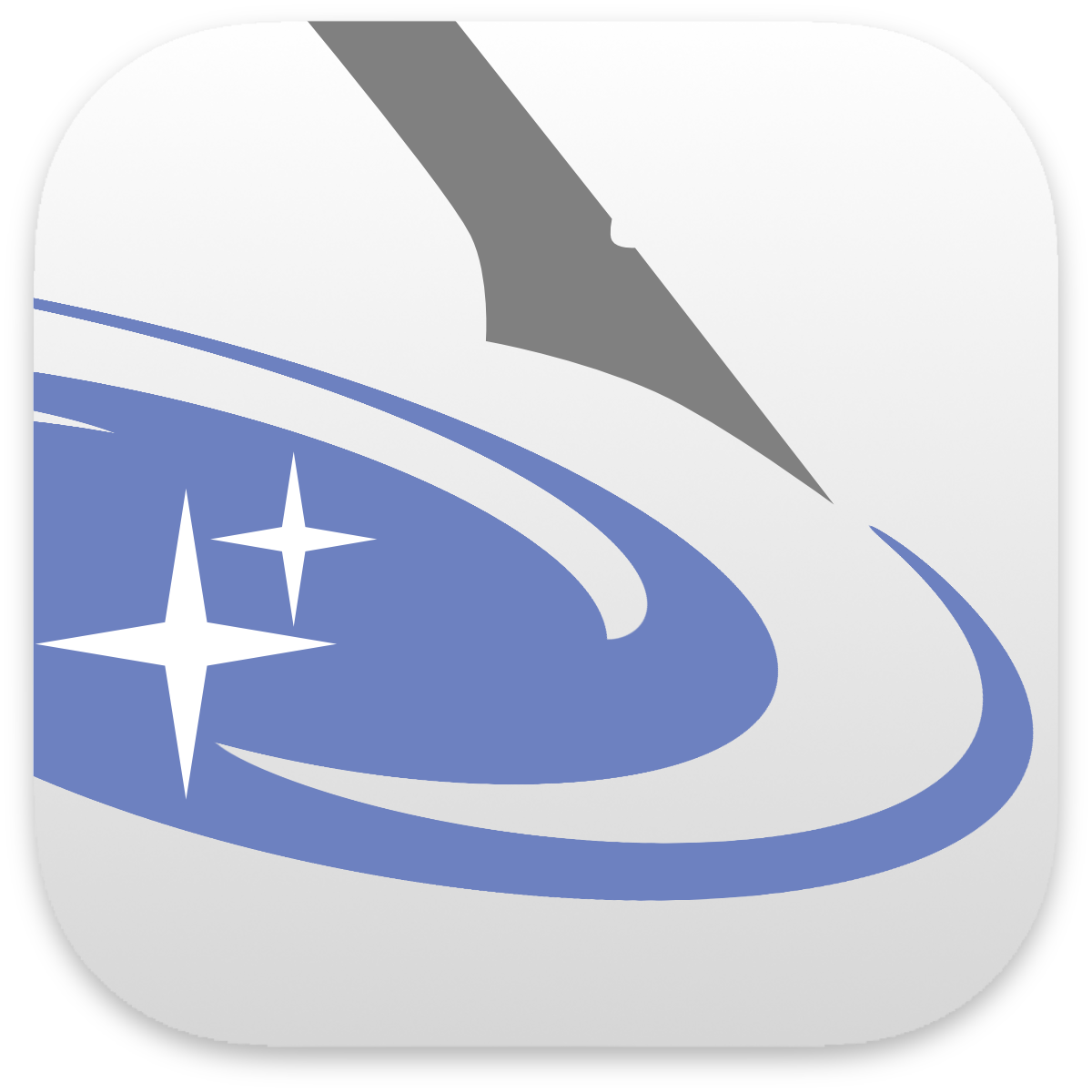
Simulating BLOBS from e-MERLIN data of X-ray binaries
October 2025



Astronomers ‘image’ a mysterious dark object in the distant Universe
October 2025


A Hyperactive FRB Pinpointed in an SMC-Like Satellite Host Galaxy
September 2025

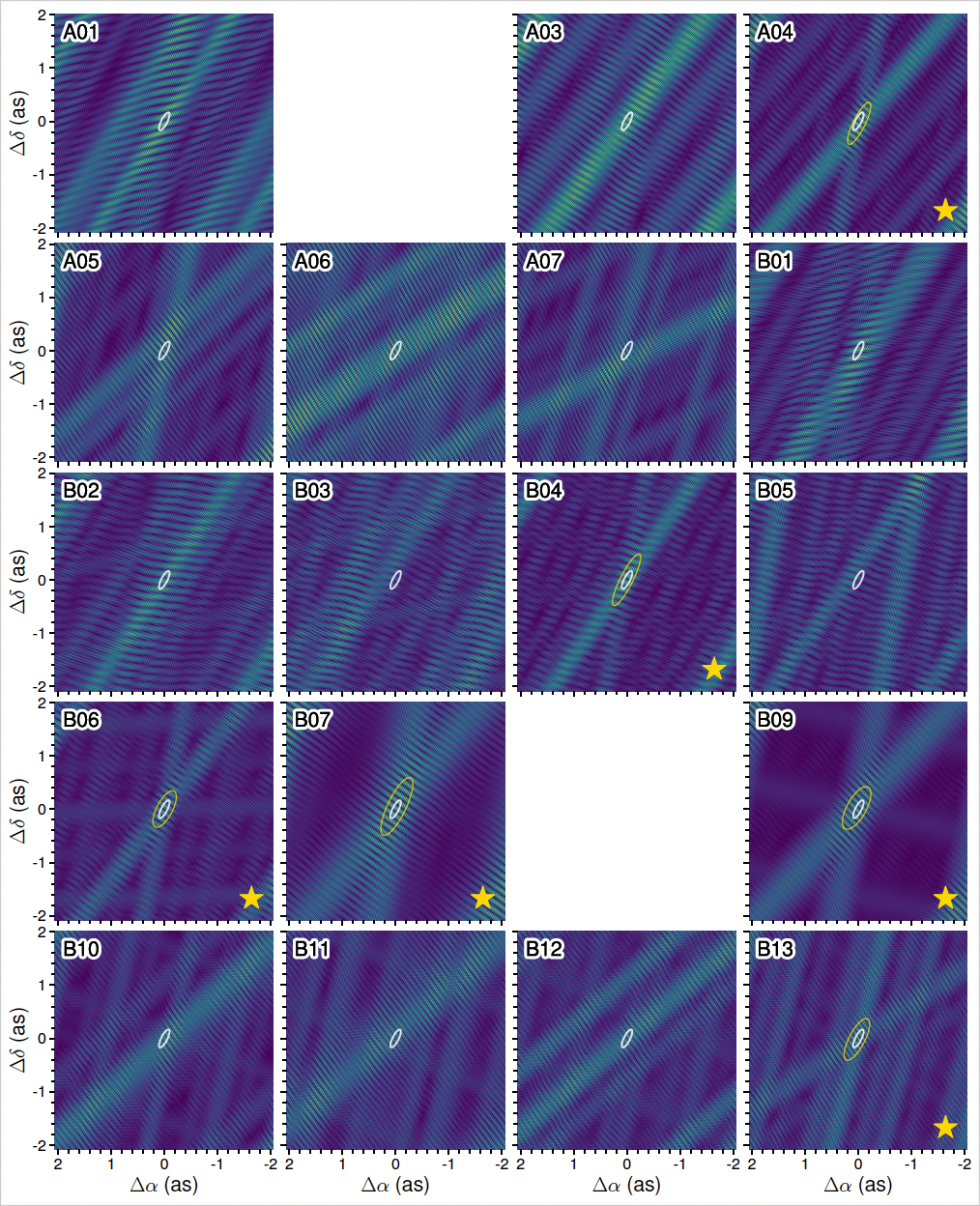
e-MERLIN Cycle 20 results announcement
July 2025
An Earth-sized radio observatory just got better: South Africa’s MeerKAT telescope joins forces with the European VLBI Network of telescopes
June 2025

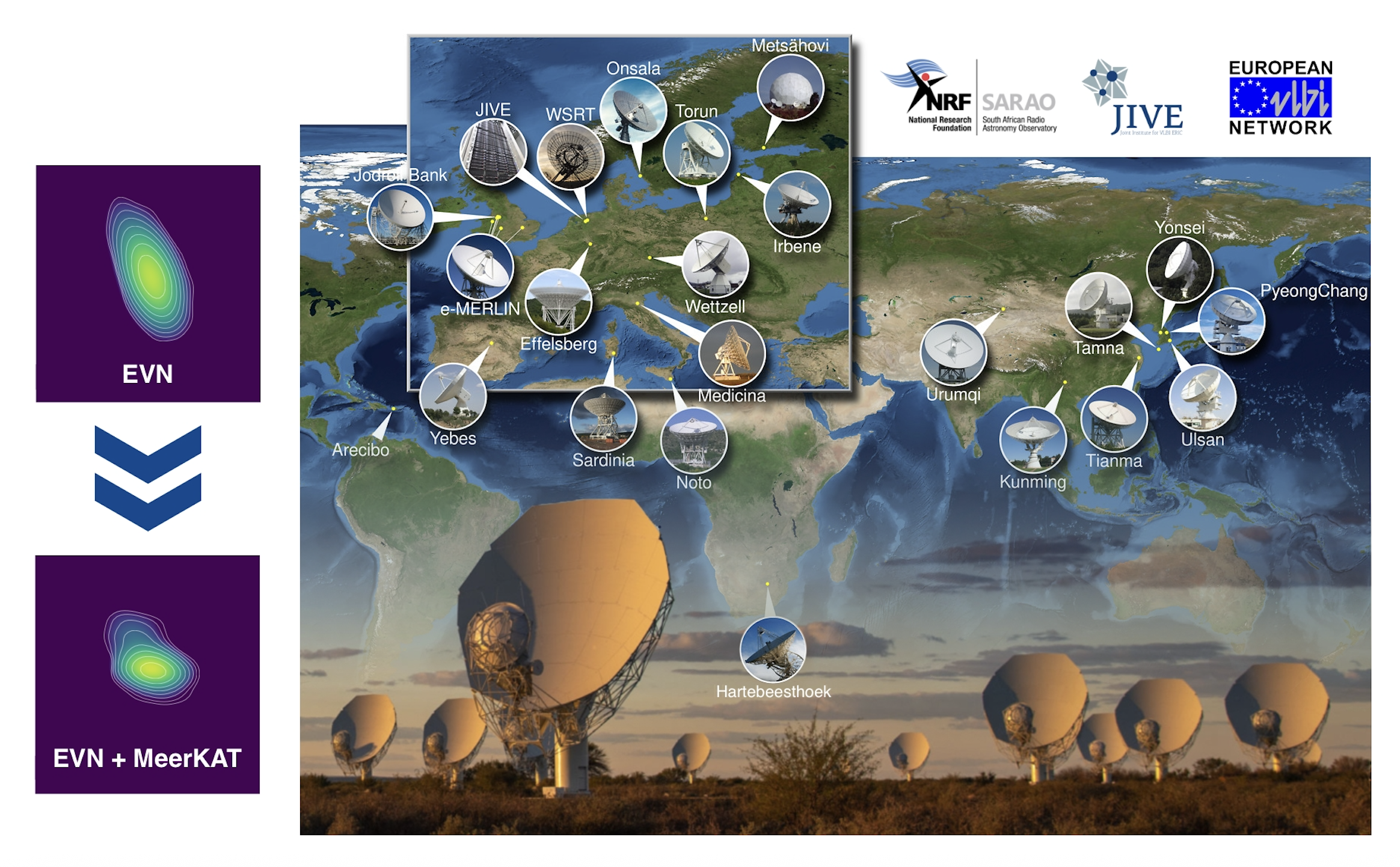
Excited for OH in HMYSOs!
June 2025


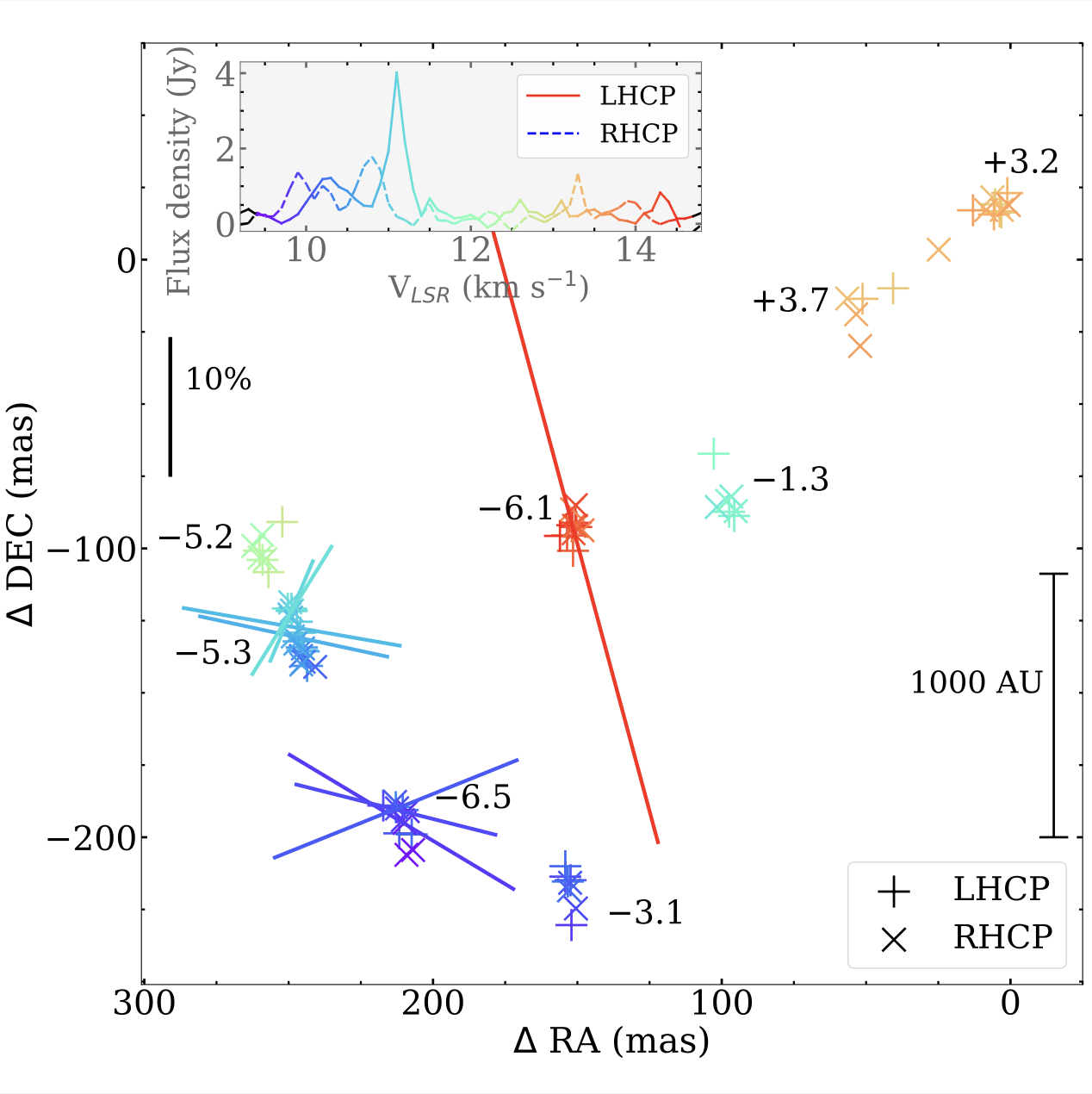
Coronal emission detected in the nearby archetypal Seyfert galaxy NGC 1068 in radio and sub-mm observations
May 2025
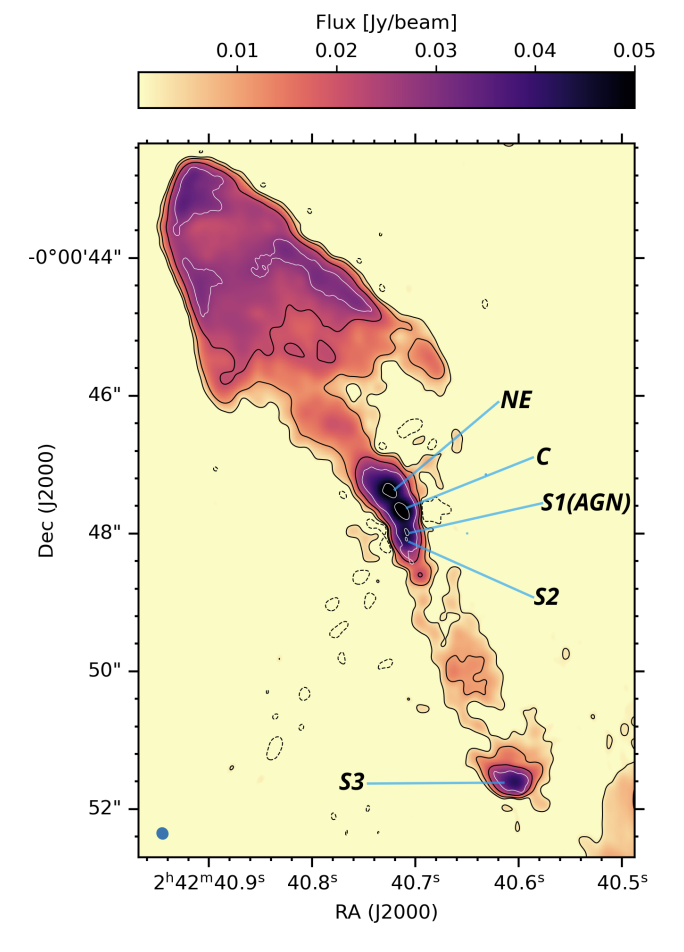

A radio counterpart to the ultra-luminous X-ray source M82 X-1
May 2025

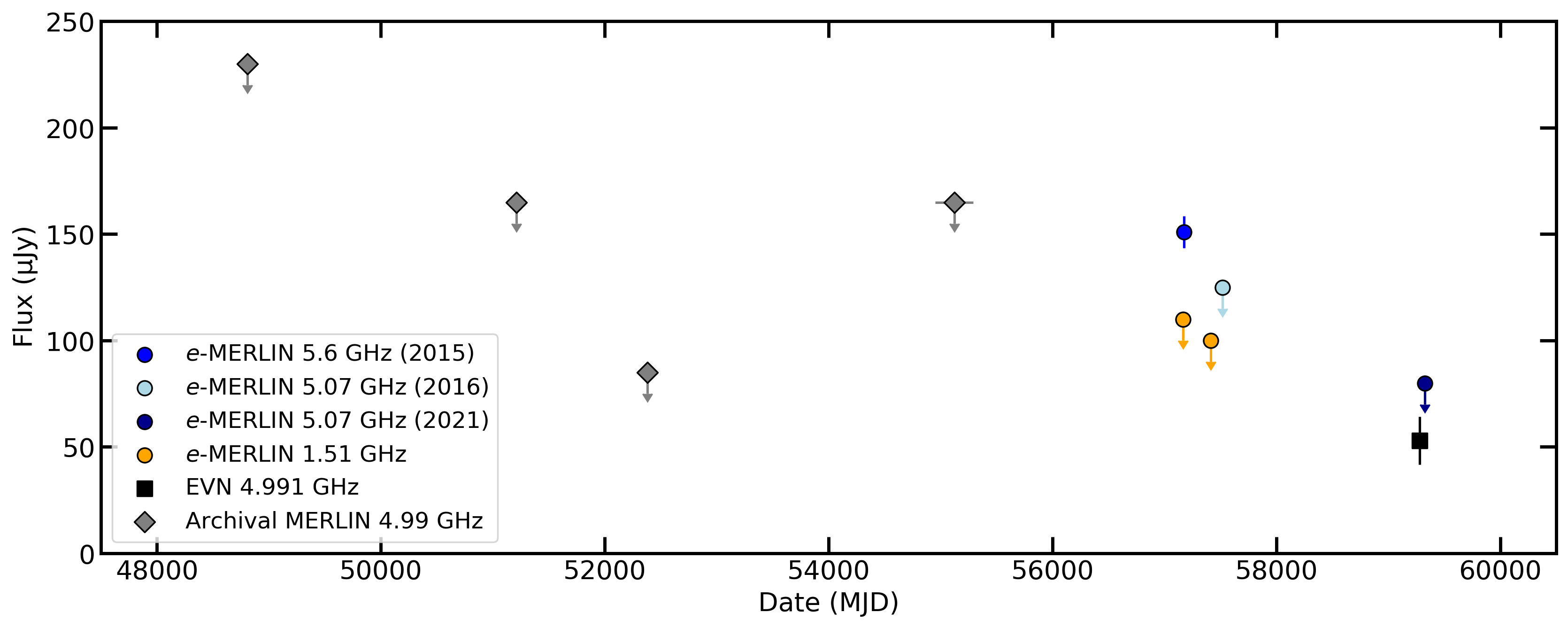
Zooming into the parsec-scale cores of the e-MERLIN legacy sample LeMMINGs with EVN and VLBA
April 2025

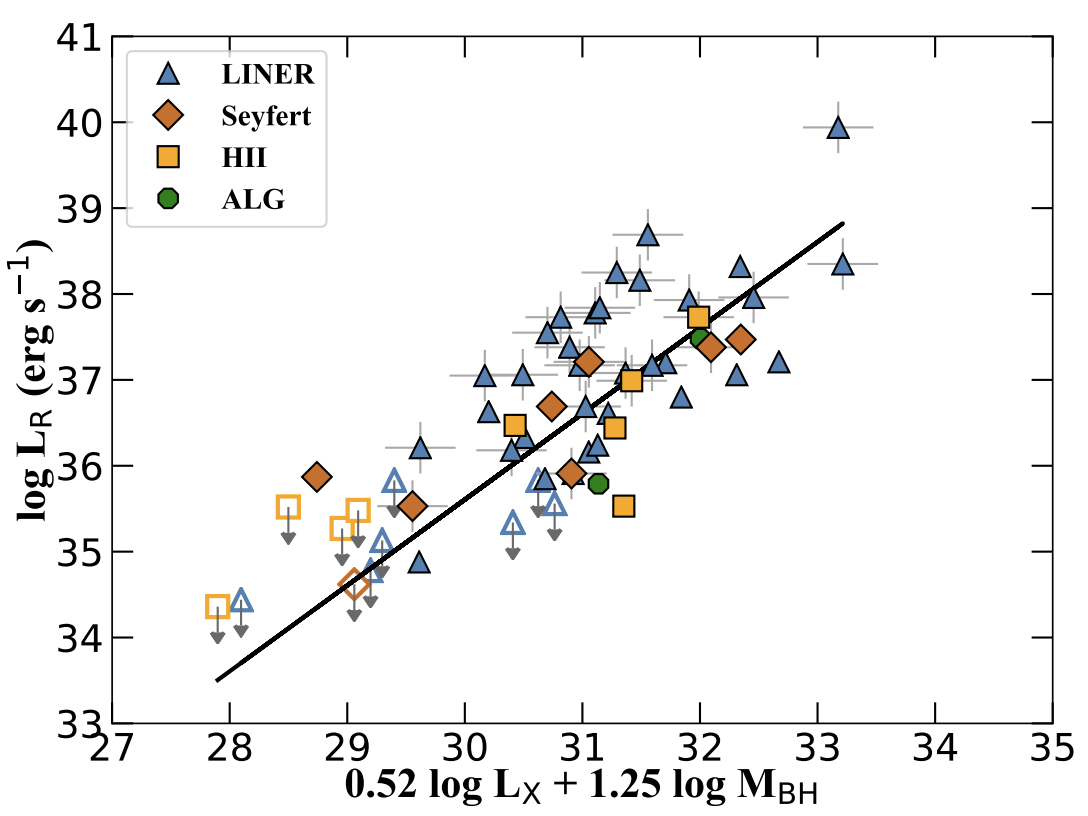
SWEEPS: The beginnings of commensal surveys with the eMERLIN–EVN
April 2025

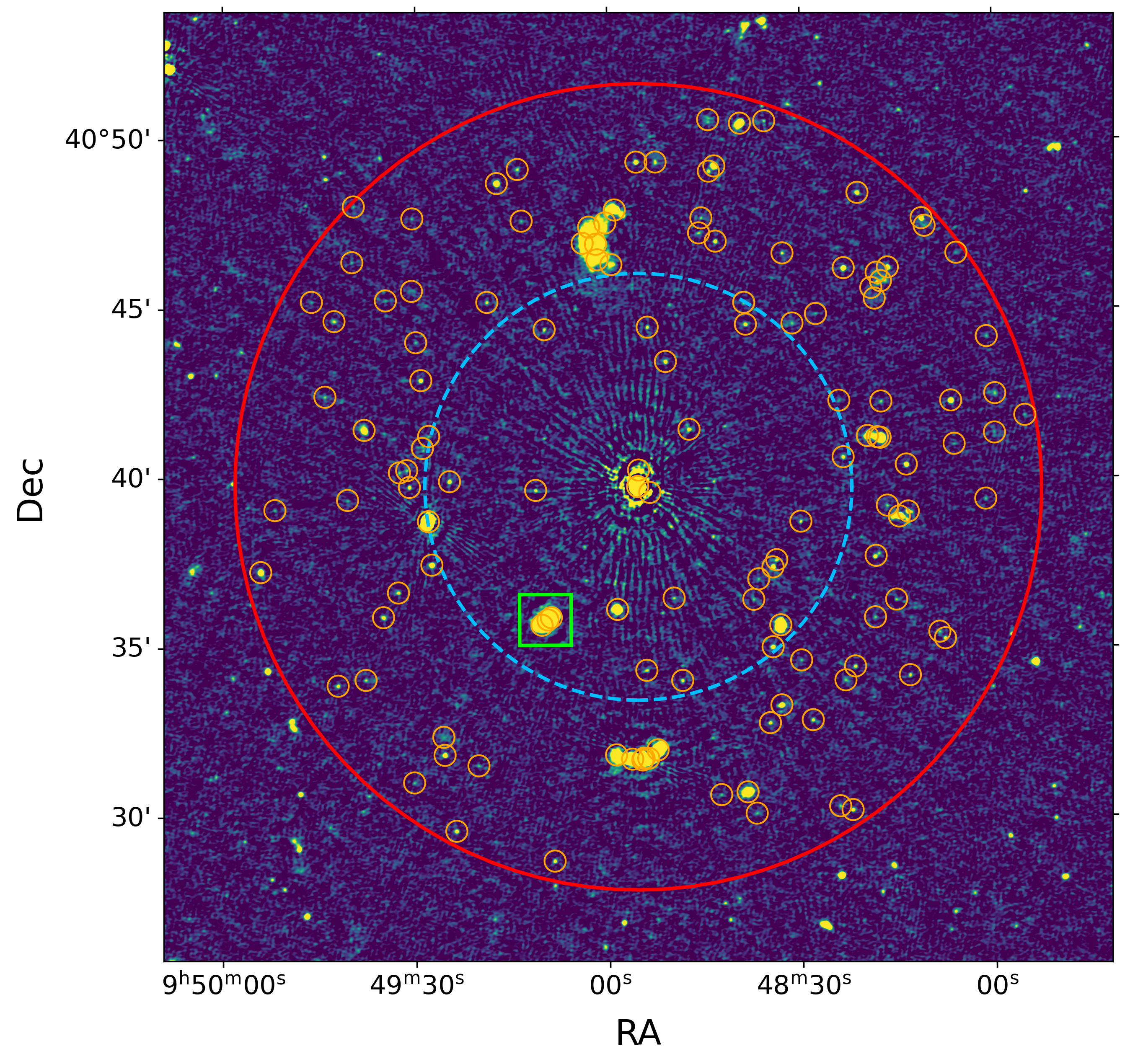
Probing the continuum of the periodic masers source G9.62+0.20E
March 2025


Submit an abstract for the SKA Pathfinders session at NAM!
March 2025
AGN Contamination Confirmed in a Dyson Sphere Candidate
February 2025

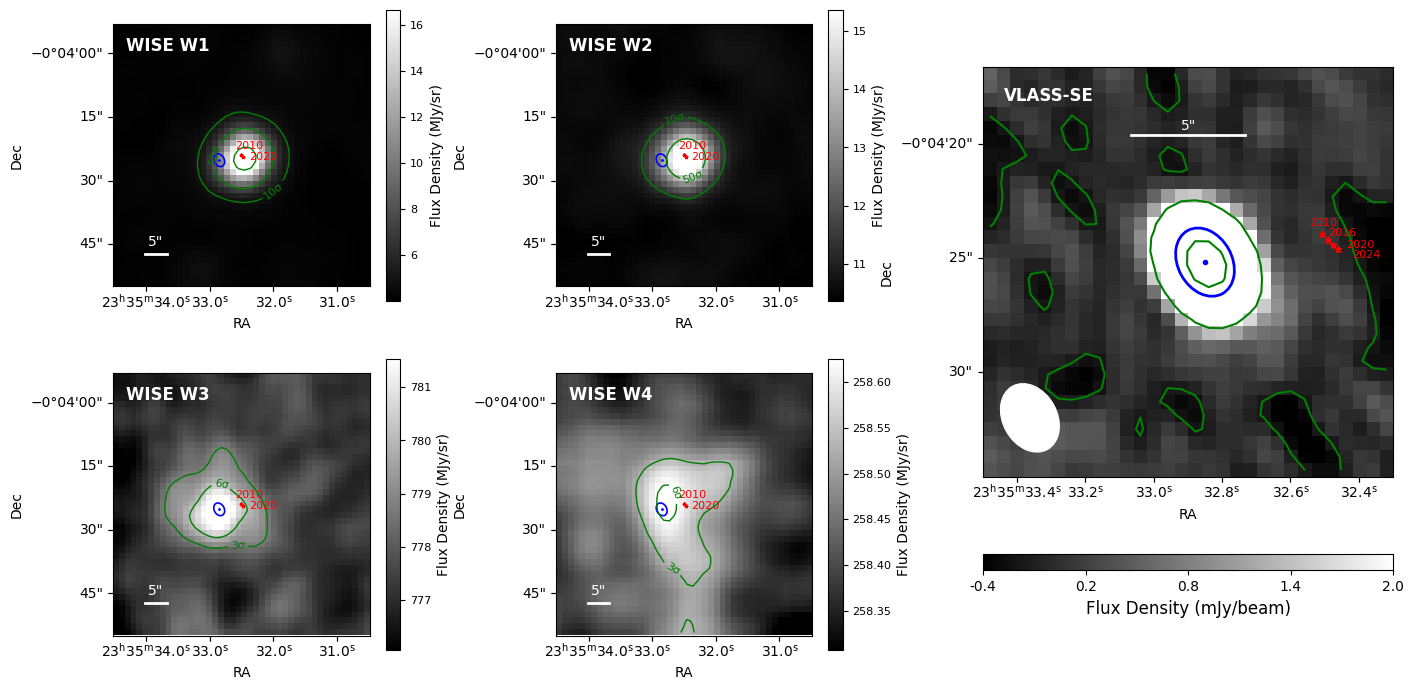
Finding winds in radio-quiet quasars
February 2025

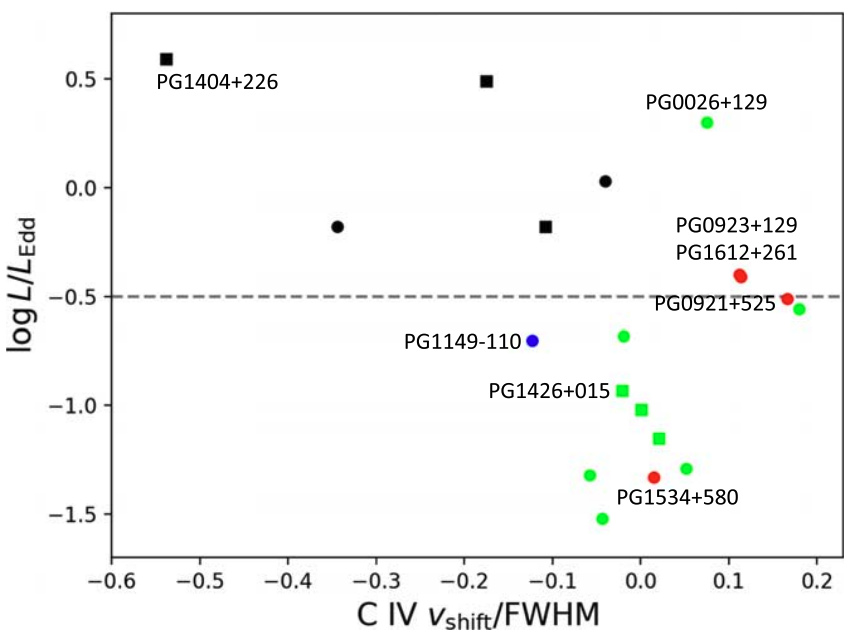
Cold Gas Outflow Driven by a New-born Radio Jet
January 2025

The quasar feedback survey: zooming into the origin of radio emission with e-MERLIN
January 2025

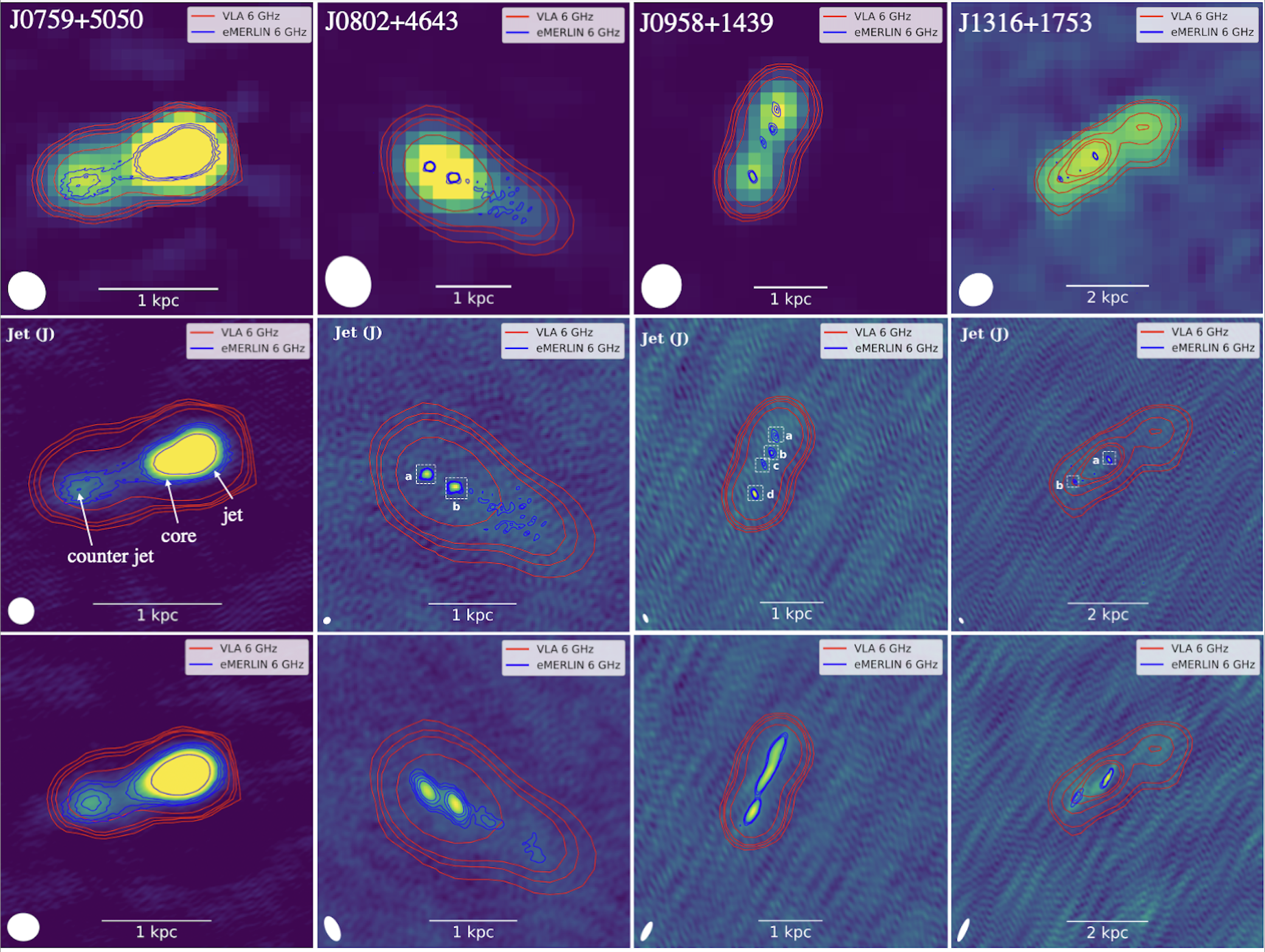
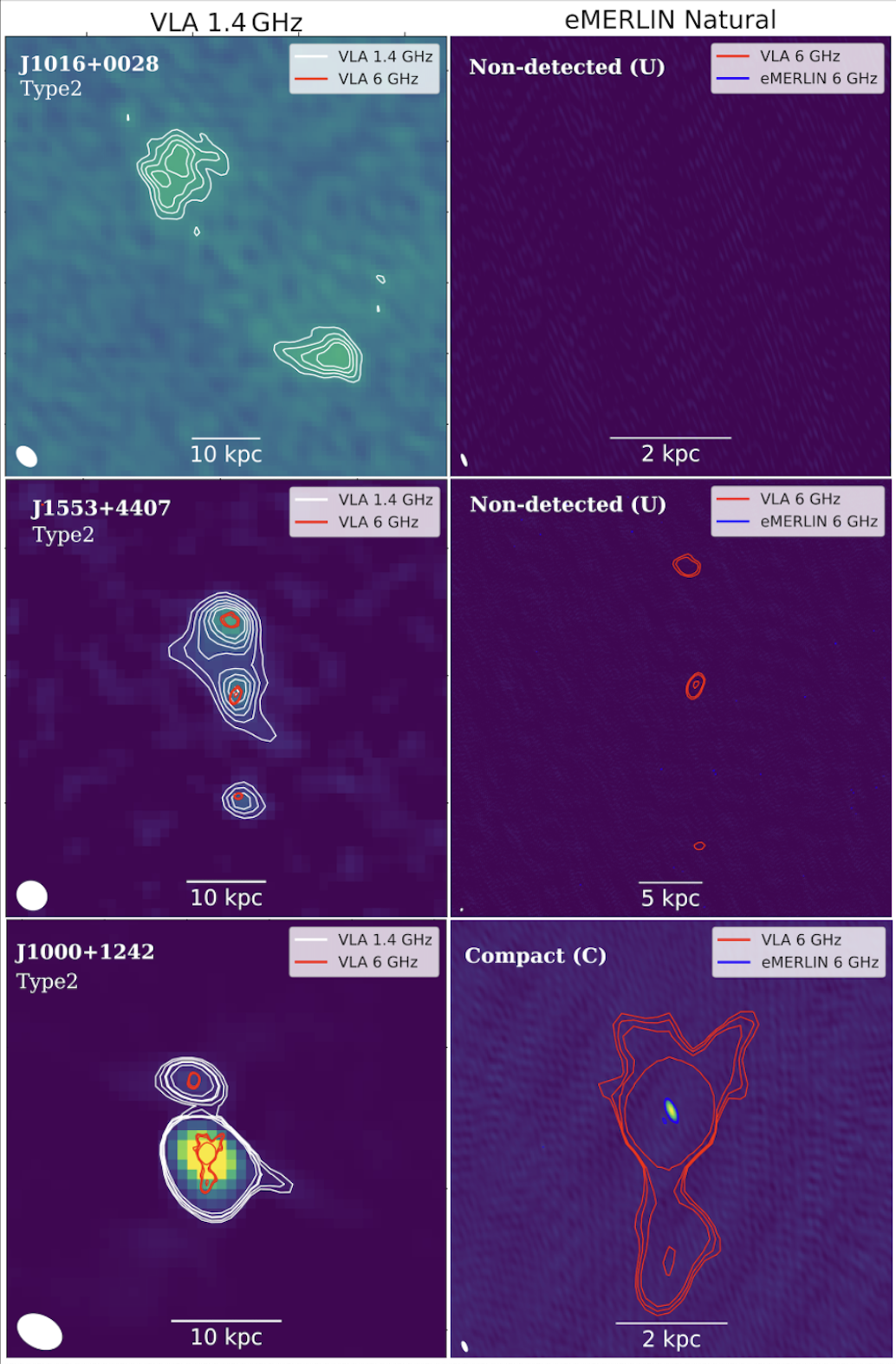
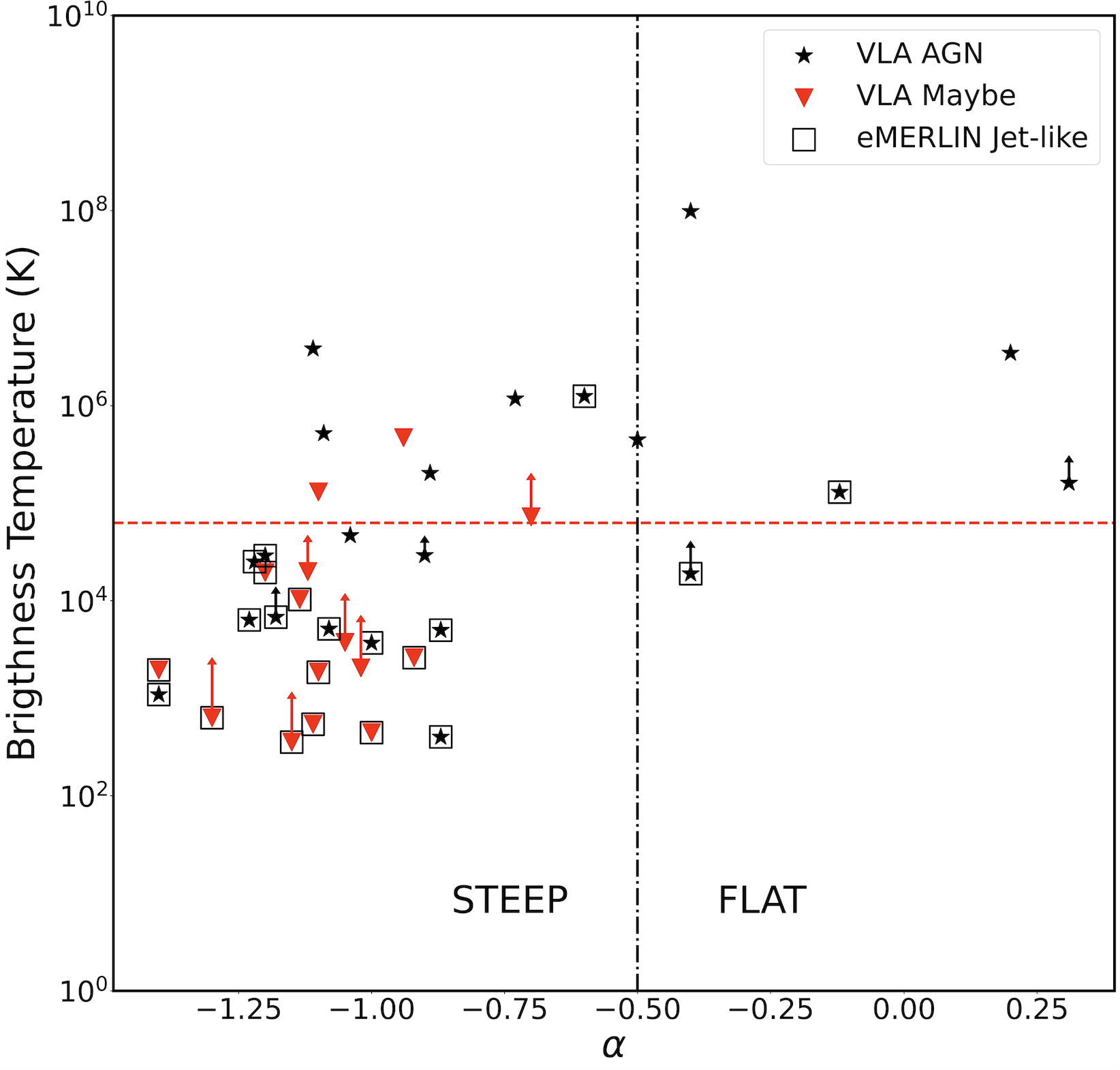
e-MERLIN Cycle 19 results announcement
December 2024
Searching for high-brightness temperature AGN cores in surveys using high-resolution radio data
October 2024
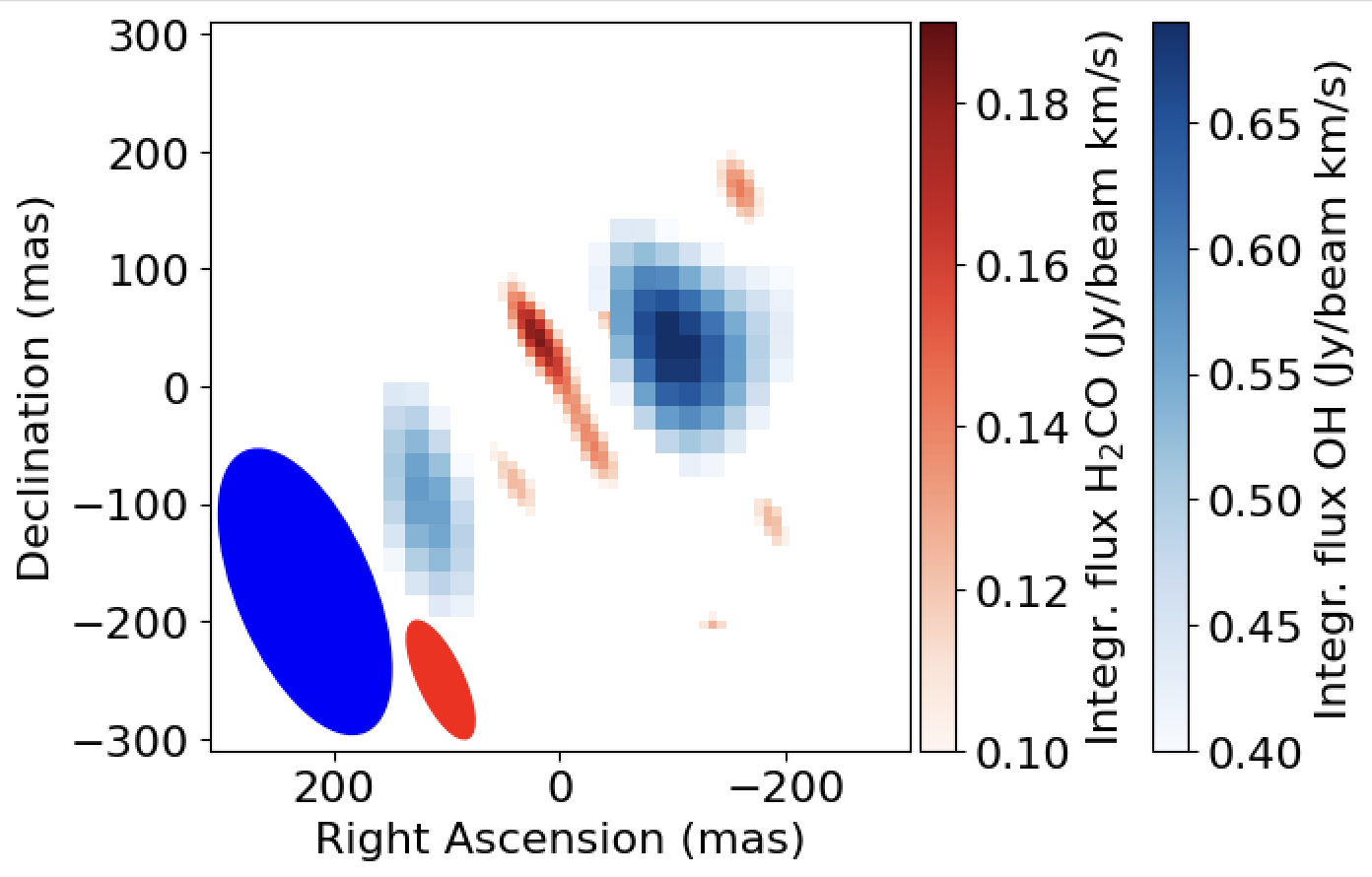
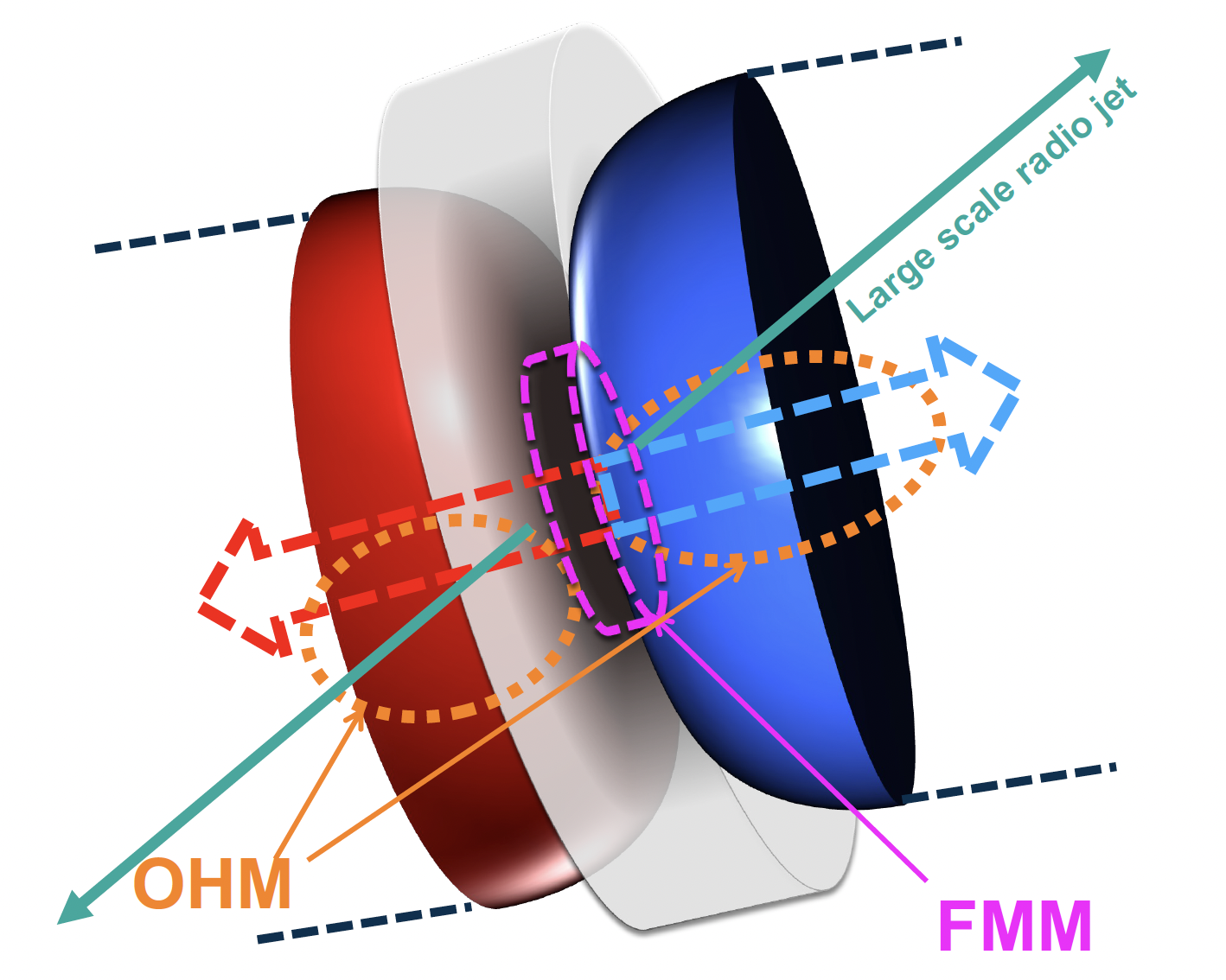
A new astrophysics centre for Multimessenger studies in Europe – ACME
September 2024

e-MERLIN Cycle 18 results announcement
July 2024
New insights on the high-mass star formation using methanol and water masers in G59.783+0.065
June 2024
